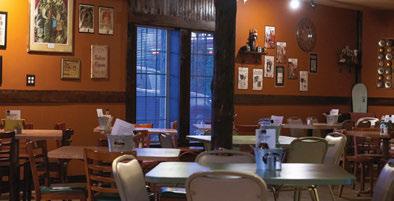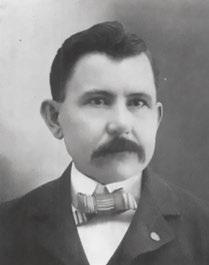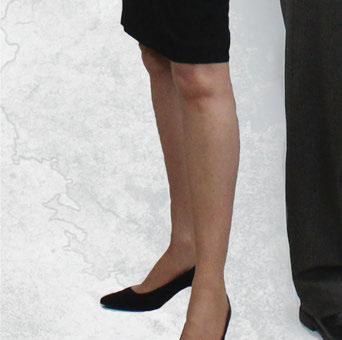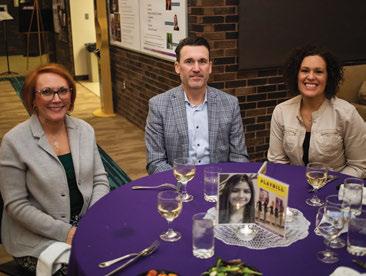


























While I always look forward to our Home & Garden issue and the warm weather April brings, it makes me realize it’s time to get busy on all the spring projects at my own home. I found a couple of ideas in our special section (p.56) that I’m adding to the list. Now, I need a nap just thinking about it.
Already on top of spring clean-up in their Flint community are Ladel Lewis and the Sarvis Park Neighborhood Association. Talk about motivation! Th e SPNA was created to “help build pride and reduce blight in the community.” Th ey are making it happen and planning for their annual Neighborhood Cleanup Day on April 23. Read more starting on p.10.
Neighbors helping neighbors – these are always great stories to share and there never seems to be a shortage. Every day, Flint residents and organizations reach out and do whatever they can for those who need help. One such organization is the R.L. Jones Community Outreach Center; their story is on p.20.
Another subject we always make plenty of room for is arts, and this issue is no exception. Actress Ava Cota of Linden has joined Flint’s Terry Crews as the only Genesee County natives to play leading movie roles during this century. Her inspiring story is on p.24. And we off er two features about superior local musical talent: the Genesee Wind Symphony is celebrating 40 years (p.30) and the Flint Symphony Orchestra’s Pr incipal Flutist Brandon LePage will be performing as the guest soloist at the concert this month (p.28). Th ere are so many opportunities for you to support local arts … they never disappoint!
Folks who have been fl ocking to Frank’s Hoppy Bistro in Fenton have not been disappointed! Th e food is just like you remember (with some great new things, too) and what’s even better is their new location is about two minutes from my house! If you’re hungry, I urge you to NOT look at p.36.
Check out the “My Haps” coverage starting on p.80 – there are so many fantastic events coming up this spring … MCM will be there hoping to “snap” you!
Th anks for reading,


VINCE LORRAINE PUBLISHER & EDITOR IN CHIEF VINCE@MYCITYMAG.COM
PUBLISHER & EDITOR IN CHIEF
Vince Lorraine
MANAGING EDITOR
Sherron Barden
ASSISTANT EDITOR / WRITER
Peter Hinterman
STAFF WRITER
Cheryl Dennison
FREELANCE WRITERS
Mark Spezia
CONTRIBUTING WRITERS
Erin Caudell
Dr. Christopher Douglas
Vera Hogan
Joel P. Lagore
Alexandria Nolan
Leslie Toldo
GRAPHIC DESIGNER
Brett LaCross
WEB DEVELOPER / GRAPHIC DESIGNER
Jonathan Boedecker
PHOTOGRAPHY
Katy Kildee
Tim Jagielo
OPERATIONS
ACCOUNTING/CIRCULATION
Kim Davis
NEW BUSINESS DEVELOPMENT
Dan Garman
ACCOUNT EXECUTIVE
Terese Allen
ISSN#1559-3436 is published monthly by My City Magazine,
phone 810.230.1783. To authors, photographers, and people featured in this publication: All materials, articles, reports and photographs in this publication are the property of My City Magazine and cannot be used without written permission. The opinions and conclusions recited herein are those of the respective authors and not of My City Magazine. My City Magazine is not responsible for returning unsolicited manuscripts, photographs or other materials. Every effort will be made however, to return rejected manuscripts, etc., if they are accompanied by sufficient first-class postage, but the publisher will not be responsible for any loss of such material.
Copyright© 2022. All rights reserved. | Printed in U.S.A.









Through all of the challenges and disappointments of the past two years, Back to the Bricks® stayed diligent, working behind the scenes to plan new events for car enthusiasts that worked with any social-distancing guidelines.
In 2021, car lovers were excited to attend an all new, one-of-a-kind event, one of the first opportunities for them to get their cars out – “Dust ‘em Off ” so to speak – and showcase them for all to see. Back to the Bricks is excited to be BRINGING IT BACK in 2022!
On Sunday, May 22 car participants will meet at the Ashley Furniture staging area starting at 8am, where they will receive their printed car placard and then be directed to the Dort Financial Event Center, entering off Lapeer Road. Car clubs will have reserved parking. The amazing MTA Trolley will provide complimentary rides from Ashley Furniture for spectators.
Participants will not pay to attend and parking will be FREE for cruisers during the event. Gates to the Dort Financial Event Center will open at 9am, and the cars will be greeted by volunteers who will hand all participants a goodie bag. Cars will enter under the iconic Back to the Bricks arches and be directed to park.
Thanks to the “Brought to You By” sponsor, Dort Financial Credit Union, all registered participants will receive a complimentary 2022 Dust ’em Off T-shirt (while supplies last). The event will kick off with a blessing of the cars and “The StarSpangled Banner” will be sung while they honor all veterans. The car show will be officially opened after brief remarks and a HUGE “thank you’’ to all the sponsors, partners, vendors and many, many volunteers who help make the event happen.
In addition to the car show, Back to the Bricks will host a swap meet giving car enthusiasts an opportunity to pick up spare parts and unique items. Pre-registered participants will be eligible to win prizes throughout the day.
Although this is not a judged event, last year’s response indicates that the turnout will be amazing and a great way to start another exciting car show season. Everyone will enjoy music, vendors, food trucks and cars … a fun day for all!




































BY CHERYL DENNISON
PHOTOS PROVIDED BY WHALEY CHILDREN’S CENTER
Mindy Williams has been the CEO of Whaley Children’s Center since 2015. She previously held every role at the Department of Health and Human Services (DHHS): Child Protective Services, Foster Care and investigations of residential facilities including Whaley Children’s Center. “I have been around social work my whole life,” says the CEO, adding that her mother was also a social worker. “That’s how I grew up.”
Whaley has a mission of “empowering youth and families to overcome trauma.” The Vision Statement is: “Through dynamic leadership and dedicated staff and volunteers, Whaley Children’s Center will be a source of hope, care, and treatment to Michigan’s abused, neglected, and at-risk children and families.” The facility provides a home to foster kids from all over the State of Michigan.
According to Williams, by the time a child comes to live at Whaley they have typically experienced as many as 12

different placements. “These kids bounce from place to place,” she says. “They have had no stability, no security and no safe place.” Currently, 42 kids live at the Center ranging in age from five to 17. “It is amazing to watch them,” Williams adds. “When they first arrive, they don’t want to talk. But over time, they feel safe enough to be kids again.”
Many children who are placed at Whaley have been through extensive trauma, Williams reports. “We see them grow here,” she says. And that is made possible through simple life changes, such as eating a good breakfast every day and settling into a bedtime routine. “Just the basic things are foreign concepts to these kids,” she sadly admits. “Some of them never knew where their next meal was coming from.”
Williams says birthdays at Whaley are among her favorite things. “Some of the kids have never celebrated their birthday,” she shares. She remembers a 16-year-old boy who was having a birthday, and the Whaley team took him to Buffalo Wild Wings to celebrate. “It was such a good day,” she remembers. They had a cake and sang “Happy Birthday” to the young man. But when they returned to the Center, she found him in his room crying. “He was overwhelmed because he never had a birthday cake.”
Williams enjoys her role as Whaley CEO. “I’m a mom,” she shares, “and I run Whaley wearing my mom hat. I want the kids to experience things they never had the opportunity to do before. During their short time here, we celebrate everything – birthdays, the Tooth Fairy – everything!” she exclaims. “They are kids and we become their family. We try to give them as much ‘normal’ as possible.”



Whaley Children’s Center was founded in 1922 by successful Flint businessman and philanthropist, Robert H. Whaley.
“The kids are safe with us and that is what is really important ... for the first time, they just get to be kids.”
Every child’s case is different and the length of their stay varies from six months to 18 months. “Some kids go back home to their parents; some go to live with relatives and some graduate from school and go to college or enter the military.” And, Whaley has an 80 percent success rate with the kids who transition to a less restrictive program, the CEO reports.
Most important to Williams is that people don’t think of Whaley as a sad place. “The kids are safe with us and that is what is really important,” she admits. “For the first time in their lives, they just get to be kids.”
Williams describes her career with Whaley Children’s Center as life-changing. “I didn’t know how much I needed Whaley. I have never worked so hard but it doesn’t feel like work. I am right where I am supposed to be.”

In 1924, The Whaley Foundation was incorporated with a mission to “serve dependent and neglected children in general without distinction to race and creed and particularly to those cases that were in trouble because of health and behavior conditions that had not been diagnosed and remedied.”
Throughout the institution’s 100 years, a number of significant additions have been made, including major renovation of the children’s living units and establishment of three group homes in nearby neighborhoods. In 1977, Whaley was one of the first agencies to offer a Treatment Foster Care Program providing children the opportunity to live with a specially trained family. During the same year, Whaley opened the Educational Center attached to the Recreational Building housing five classrooms, offices and a meeting

room. In 1982, a Special Needs Adoption program began and in 1991, the C. S. and Ruth Rawlings Mott Residential Center was opened as a state-of-the-art treatment facility. The Whaley Memorial Building was remodeled in 1993 to accommodate clinical, foster care, adoption, administrative, human resource, finance and development offices.
Each year, Whaley provides shelter, hope and healing to nearly 70 children who are survivors of horrific abuse and neglect. Through an intense treatment process provided by qualified and dedicated staff, children are taught the skills necessary to thrive in life, as well as strategies to cope with their past and move forward to brighter futures.
Source: Whaley Children’s Center



1
What was your very first job?

INearly February, Patrick Scanlon assumed a new role as Executive Director of the Flint River Watershed Coalition (FRWC).
Most recently, Scanlon served as the Cooperative Invasive Species Management Area (CISMA) Coordinator at the Genesee Conservation District where he provided invasive species education and outreach to four counties that intersect the Flint River watershed. He is also a past Flushing City Council member and serves on the Flushing City Parks and Recreation Committee.

To his new position, Scanlon brings extensive environmental knowledge and a deep passion for conserving Michigan’s natural resources. An avid kayaker, he earned a B.S. in Wildlife Biology at UM-Flint.
In addition to overseeing day-to-day operations, Scanlon will also lead fundraising, strategic partnerships and community engagement initiatives. It will be a busy year for the FRWC as it prepares to move to a new location at the confluence of the Swartz Creek and Flint River later this year.
The FRWC is a membership organization that promotes citizen stewardship of our natural resources by providing members with the resources necessary to protect local water quality and watershed habitat. With Scanlon at the helm, they are excited to further advance their mission.
In this feature, My City readers get a bit “up close and personal” with Patrick Scanlon.
My very first job was at a local grocery store. I worked primarily as a cashier but also pitched in on other day-today duties. It was a great first job and it taught me a lot about responsibility and working together as a team. I still shop there, too, and always think about when it was me on the other side of the cash register some 20 years ago.
2 Do you hit the snooze button or wake up immediately?
I am an up-and-out-ofbed kind of person. Falling back asleep is not an option because I am immediately thinking about everything I have to do. Plus, I look forward to my morning mug of matcha to help get me going.
3



When you were a kid, what did you want to be when you grew up?
eight years old, my grandma bought me a used microscope at a garage sale and opened my eyes to a whole new world. I never grew tired of riding my bike around the neighborhood to collect samples of pond and ditch water to see what myriad of creatures were living in these microcosms. At some point, I decided I wanted to be a scientist. I now think that being a scientist isn’t necessarily just an occupation, but a way of life. We can all be scientists in our own way based on how we look at and interact with the world around us.
4
What do you do to keep fit?


At an early age, I had fallen in love with the natural world around me and wanted to incorporate that into my future whether it be as an occupation or otherwise. My family has always nurtured my strong interest in wildlife and one Christmas, I received a book detailing all of Michigan’s wildlife. I spent hours studying the masterfully drawn pictures and descriptions of things that I might spy upon if I kept searching my surroundings. And I never stopped looking. When I was around
I try to hike and kayak as much as possible. Much like the younger version of me, I want to get out into the world and see as much as I can. I want to look under every rotting log I come across and inspect the creatures under the river rocks. I also thoroughly enjoy spending time with my four-year-old niece. Even though it may look like she’s trying to keep up with me, I’m the one trying to keep up with her seemingly unending energy! I like showing her the natural world that first caught my attention at her age. Catching salamanders, observing bugs, inspecting mushrooms and overturning logs to see what else we may spy is immensely rewarding as I witness her reactions to seeing some of these things for the very first time. Being a naturalist can







wildlife around me, and now I have a computer in my pocket that I can take pictures with and an app that can identify what I’m looking at while also sharing it with the rest of the world. It has become a big part of my daily life; so much so that I find it is important to take time to disconnect from it at times and appreciate that which exists beyond the screen.
7
If you had a warning label, what would it say?
burn some serious calories, especially with a young enthusiast in tow! My garden, however, is the ultimate zen for me. Starting seeds, tending to the plants and bringing them to fruition is amazingly rewarding for me and a welcome escape from daily stress.

5 What’s one workrelated thing you want to accomplish in the next year?

I hope to accomplish a lot! I am incredibly excited to be guiding such a wonderful organization and the incredible group of people who are my staff. I have said that I feel like I have been given the keys to
a brand-new speed boat and once I figure out how to drive it, we are going to make some waves! One thing I would like to accomplish is to not only maintain the organization’s success and momentum, but also build upon it to reach more of the communities within the entire Flint River Watershed and expand our connection with people of all ages and walks of life. We have our Kayak Flint program which gets people out on the river, our educational programs which bring amazing resources and lessons to classrooms, and our various events which give people an
opportunity to get involved and support the FRWC.
6 Aside from necessities, what one thing could you not go a day without?

The biggest thing for me is technology – whether that is my phone, computer, tablet, or even the TV. I can connect to news releases and research articles, interesting documentaries and even my friends and family who make up my support group. Technology and the internet are incredibly valuable tools that I think we sometimes fail to appreciate.


As a kid, I had a handful of books that showed me the
It would probably read something like “WARNING: I WILL TELL YOU MORE THAN YOU CARE TO HEAR ABOUT INVASIVE SPECIES!” In my previous position at the Genesee Conservation District, I spent three years helping to educate the community about invasive species. I still feel the need to tell people they have Phragmites creeping into their yard, or that they should remove the Japanese barberry plants from their landscaping. If at any point they dare ask why, then I unleash loads of information as to why these plants are harmful and how they can remove them. I am that guy who has no issue with shaming his friends and family for intentionally planting known invasive species in their yards. And have you heard of spotted lanternfly? Let me tell you about this invasive insect you are likely to encounter in Michigan in the future …
BY PETER HINTERMAN
PHOTOS PROVIDED BY SARVIS PARK NEIGHBORHOOD ASSOCIATION
Ladel Lewis has seen it all. Born and raised in Flint’s Sarvis Park neighborhood, she has seen the community at its best and returning to the area in 2019 to care for her ailing father, found it most troubling. “The community was in a tough place. There were bullets in the streets and many residents felt like they were living in prison,” she explained. “Many of them were on a fixed income, invested in their homes, and didn’t want to leave. There were a lot of problems. They deserved better. I said to myself, ‘no more’.”
Lewis got to work and with help from neighborhood residents, created the Sarvis Park Neighborhood Association (SPNA) to “help build pride and reduce blight in the community.”
The SPNA is built around making Sarvis Park a community hub and public center but is working toward
doing much more. Lewis acts as president. “We are bigger than just doing projects in the park,” she says. “We want to improve the quality of life for families around it by establishing pride and feelings of security.” Lewis and residents started by cleaning up blight in the park and neighborhood at the now annual
Sarvis Park Neighborhood Cleanup Day, this year scheduled for April 23. “It’s a whole vibe,” says Lewis. The event gathers the whole community for a morning of hard work ending in a shared lunch. “We have become a park adopter and work together with Keep Genesee County Beautiful,” she adds. “The City of Flint has very little money to devote to parks, so we want to do our best to help.
Blight removal not only raises property values, it raises spirits, as well.”
The SPNA has plans for enhancements to the park including playground accessibility, new picnic tables and bleachers, and thanks to a grant from the Disney Corporation, a new soccer field – an up-and-coming sport for area kids. The grant will


also benefit nearby Iroquois Park by helping to increase handicapped accessibility and renovate the current baseball diamond. “We are working with AutoZone for the installation of a new baseball diamond at Sarvis Park,” adds Lewis. “One goal is to ensure that we use all the 12-plus acres in a reasonable way. We have a beautiful nature area that will stay the same and we are even making plans to enhance that by planting
trees.” Lewis is applying for grants to build a complete sidewalk around the park so area residents have a place for exercise. A hoop-house and garden have also been built and cultivated and is open to area residents for access to fresh vegetables. “We bring in guests to read to neighborhood kids for our ‘Reading in the Garden’ program,” adds Lewis. “The kids love it and the books usually involve the subjects of gardening and nutrition.”

In addition to park cleanup and enhancements, the SPNA has worked to increase neighborhood security by obtaining and installing solar yard lamps, Ring doorbells and porch lights at select residences. “To date, we have installed 25 solar yard lamps, 11 Ring doorbells, and three porch lights,” Lewis updates. “We will also be posting ‘Community Watch’ signs that were recently purchased.”

The SPNA is collaborating with state and local police in an effort to forge a positive relationship between them and the community. The departments were extremely receptive and have designated their own State Police Community Day when the officers mingle with, serve
food and cater to the residents. The police have expanded to other area neighborhoods to build positive relationships. “We have a feeling of togetherness here because of the improved law enforcement relationship,” Lewis explains. “People know that our area is different now – the freedom to cause trouble isn’t there
so much anymore. People tell me that they feel safer now.” To increase civic engagement, the SPNA also conducts monthly “Community Conversations’’ at the nearby police mini-station (corner of Bishop & MLK Blvd.) every third Tuesday from 9-11am, focusing on a variety of topics such as how to spot elder abuse.

Because of the efforts of the SPNA and its community, Sarvis Park is quickly becoming a go-to place for local families and city celebrations. “The park is being used for city-wide events now,” says Lewis. To further make Sarvis a “destination” park, the SPNA has eyes on obtaining a nearby vacant lot for possible use as a food truck lot. This summer, Lewis and the SPNA plan to host a variety of fun events and programs in and around the park including their annual cleanup day, the Northside Stride 3K Fun Run at Max Brandon Park, the much-anticipated Caribbean Beats & Eats Celebration this summer, and a September Community Day celebration. Starting again this summer are the Art in the Park, Music in the Parks (starting August 2) and Fitness in the Park programs.
“Nothing like seeing a bunch of

people doing yoga outside in the park on a sunny day,” Lewis laughs.
In addition to her role as SPNA President, Ladel Lewis also represents the 2nd Ward on the Flint City Council but the additional duties haven’t slowed her down, even a little. She and her community have big summer plans for resident home renovations and more. They are recreating a lost sense of neighborhood that has abandoned much of the city’s streets. The SPNA
serves as a model for community healing and Sarvis Park area residents are smiling again. The pride is coming back big time and SPNA is leading the way. “We just want to enjoy our neighborhood.”
• April 23 – Clean-Up Day
• June 18 – North Side Stride 3K Fun Run
• June 19 - Youth Art Showcase
• August 3 - National Night Out
Ice Cream Social
• August (TBD) – Caribbean Beats & Eats Celebration
• September 10 – SPNA Community Day
For news updates and more information, visit the Sarvis Park Neighborhood Association Facebook page or email Llewis@cityofflint.com.

BY JASON HARROD, MA
Ifyour child is sick and you’re in search of a diagnosis, you can get the care they need right here in Flint. As an infectious disease specialist and certified general pediatric hospitalist at Hurley Medical Center, Dr. Rafe’e specializes in determining what is making your child sick. He sees pediatric patients in the Flint area, and is especially experienced in diagnosing infectious diseases. You can visit his office in the Hurley Children’s Center, located near the Flint Farmers’ Market, where you can access expert primary care and a wide range of referral-based specialty care for your child.
Besides providing primary care services to his own patients, Dr. Rafe’e is commonly consulted by other community pediatrics and ER doctors in need of help in diagnosing a child. A common situation he sees is a child with an unexplained fever, who is suspected of having an underlying infection or complication. These complications can take varying forms, from abscesses to multiinflammatory symptoms. His unique combination of experience in the county, expertise as an infectious disease specialist, and the skills of a certified general pediatric hospitalist allow him to help provide the highest level of care for children across the state.
While many symptoms help reveal illness and the need to seek treatment, Dr. Rafe’e highlights fever as one of the main ones. Specifically, if your child has a fever for two days without good explanation, they need to see a doctor. Other symptoms that occur along with a fever can also help you recognize the need to seek treatment. These include not wanting to eat or drink, trouble breathing and acting lethargic.

A newer issue that Dr. Rafe’e has observed is called Multiinflammatory Syndrome (MIS-C). Often associated with COVID-19, it can occur within eight weeks of a child being exposed to the virus, and is not dependent on the child having the illness. It is considered a syndrome, a collection of symptoms and not a disease, and happens when the body responds late to COVID. MIS-C affects organs and symptoms can reflect the area of the body under stress. Because of this, there are many possible symptoms including skin rashes, rapid breathing and fevers that last 24 hours or longer. The good news is that Dr. Rafe’e has a good amount of experience in diagnosing and treating MIS-C and is able to help your child if the need arises.
Dr. Rafe’e is able to provide high-quality care to patients not only because of his expertise and experience, but also because he works with an interdisciplinary team at Hurley Medical Center to assess what patients need on an individual basis. He says that keeping treatment centered around family allows for a high level of care, explaining that “the treatment team rounds to each bedside to ensure that everyone, both the treatment team and family, is on the same page and understands the treatment plan.”











BY AMIR ABU-AITA
Elder Law Attorney is an advocate for the elderly and their loved ones. Most lawyers specializing in elder law handle a wide range of legal matters affecting an older or disabled person, including issues related to health care, long-term care planning, guardianship, retirement, Social Security, Medicare/Medicaid and other important matters.
What is the difference between elder law and estate planning?
Elder Law is the practice of planning for disposition of assets and other aff airs while a person is still living but may require care or protection of assets. With estate planning, an attorney helps you implement a plan of what will happen to your assets after your death.
An elder law attorney can provide assistance with any one or more of the following:
• Help with the preservation or transfer of a person’s assets, whether they are single or married.
• Assist those already on Medicaid in preserving assets and avoiding the Michigan Medicaid Estate Recovery Program.
• Guide with selection and appointment of a legal guardian.
• Prepare estate planning documents.
• Assist with long-term care placement in senior living communities and nursing homes.
• Handle Medicare and Social Security appeals and claims.
• Assist in cases of elder abuse and fraud.



Q: Will Medicare pay for a longterm stay in a nursing facility?
A: Generally, Medicare covers only up to 100 day s of “skilled nursing care” (20 full-pay days and an additional 80 co-pay days).
Q: Must a nursing home resident spend down all assets, including the home, before he/ she can get Medicaid?
A: No. Generally, a person can retain one house, one car and $2,000 in countable assets while on the Medicaid Program. If the applicant is married, the community spouse (a spouse not in the nursing home) is provided spousal impoverishment protections that allow him/ her to retain some marital assets.
Q: Can a Medicaid applicant gift all of their assets to a spouse or child and immediately qualify for Medicaid?
A: Generally, there is a penalty if you transfer assets within five years of applying for Medicaid; however, there are exemptions to this rule.
Q: To qualify for Medicaid, can I hide or not disclose my assets on the application?
A: Intentionally lying on a Medicaid application is a crime – don’t do it!

Q: Can the Michigan Medicaid Estate Recovery Program take my home after I die?
A: Through this program, states recoup expenses paid for long-term care from the estates of individuals over the age of 55 who received Medicaid assistance. Estate recovery comes into play only after the death of a person who was eligible for Medicaid assistance and received long-term care Medicaid benefits.
Q: Is a nursing home the only option to obtain care while on Medicaid?
A: There are several care options that are funded by Medicaid or a Medicaid supplement program. For example, Medicaid can pay for part of nursing home costs, while the

MI Choice Waiver Program and PACE Program can assist with paying for in-home care or some assisted living home-care.
Q: Can I plan and apply for Medicaid myself?
A: Medicaid is a complicated program to understand and appl y for; making a mistake on the application could be costly and detrimental to one’s estate. To assist with this process, I recommend contacting an Elder Law Attorney; it will save you time, money and headache.
*Disclaimer: The contents of this article are provided for informational purposes only and should not be construed as legal advice. You should not act or refrain from acting based on any information in this article without seeking legal or other professional advice. This article contains general information and may not reflect current legal developments or address your situation. We disclaim all liability for actions you take or fail to take based on any content herein.
Amir E. Abu-Aita practices Elder Law, Medicaid Planning, VA Planning, Probate, Estate Planning, Business Transactions and Assisted Living Law. He is a member of the Genesee County Bar Association as well as Elder Law and Probate Sections of the State Bar of Michigan. Abu-Aita is also an accredited attorney through the Department of Veterans Affairs, Office of General Counsel. In addition, he serves as member of the Genesee County Commission on Aging, Adult Foster Care Providers, and is President of Elder Abuse Alliance (formerly known as the Elder Abuse Task Force).











BY


“The city needs so much and we see it every day. People need just a little bit of hope to help them through.”
SANDRA JONES, CEO

For Sandra Jones, CEO of R. L. Jones Community Outreach Center, it all starts with being a good neighbor and caring for the community. “I remember a time when neighbors helped each other,” she says. “At R. L. Jones, we work hard to meet the needs of those who need help and we are strong advocates for the city and its people.”
The R. L. Jones Community Outreach Center (COC), named for Bishop Roger L. Jones of Greater Holy Temple C.O.G.I.C., was founded in 2016 during the water crisis to be a bottled water distribution center organized by the state and run by local residents. As the COC began delivering cases of water to those affected by the crisis, Jones and her team found that people needed much more. “It opened up my eyes,” she remembers. “People needed food, clothing and hope.”
Jones worked with the Food Bank of Eastern Michigan (FBEM) and the Michigan Department of Health and Human Services to begin food distribution. “Th e best way to mitigate the eff ects of lead poisoning is

good nutrition,” she states. “Th e area we operate in is a food desert and the only place many can get food are corner stores or Dollar General.” Th e need for food and water was so great that vehicles would line up for miles. “Each car carried multiple families – we were helping nearly 10,000 people per week.”
Soon enough, Jones realized that in order to provide help to all who needed it, she would need to establish a 501(c)(3) nonprofit organization. With tutelage and financial help from the Ruth Mott Foundation and with The United Way as fiduciary, R. L. Jones COC began expanding the reach of their operation.
One of the first steps the organization took was to begin helping the community’s “forgotten” people –those who couldn’t travel to get water or food due to illness, disability or lack

of transportation. They partnered with Flint’s Mass Transit Authority (MTA) to transport food and water. “We started delivering to 30 families and we now deliver weekly to nearly 1,100 households,” informs Jones.
In a partnership with Carriage Town Ministries, R. L. Jones COC has maintained the Closet of Hope Project since 2017. The Closet holds adult and child’s clothing, personal care items, toys and household items, etc. for those who need it. “Any clothing or items donated to us or to Carriage Town Ministries and other Flint organizations gets thoroughly cleaned and is available for anyone who needs it,” says Jones.
Asanother avenue to provide for its neighbors, R. L. Jones COC also offers job training to its volunteers and employees from Michigan Works! helping them obtain forklift certification, logistics training and general job skills. “I am a firm believer in teaching a man to fish,” says Jones. “We have had employees go on to receive their GED and achieve bigger and better things, some able to buy homes and transportation. We’ve helped them get driver’s licenses and more. And, we have workers who have been with us since the beginning and thanks to our funding, have been able to provide them a good wage.” R. L. Jones has also acted as a healthcare and vaccination station for Greater Flint and recently became responsible for handling the majority of Flint’s 2-1-1 calls for essential community services.
The good work of R.L. Jones would not be possible without the help provided by multiple organizations, foundations and individuals. “It was very hard for us in the beginning and through the pandemic,” says Jones, fighting back tears. “We wouldn’t have been able to keep the doors open without the Ruth Mott Foundation, The United Way, and Isaiah Oliver at the Community Foundation of Greater Flint. We wouldn’t be able to pay our employees and continue deliveries.” Even more organizations have come forward to help. As one of Flint’s three points of distribution, R. L. Jones COC will have its parking lot completely redone courtesy of the Mott Foundation. NBC25 Owner Armstrong Williams completely insulated the COC warehouse space and provided heat to the building. “We were working in long coats, gloves and hats during the winter months and Mr. Williams volunteered to help us,” clarifies Jones. Gazall Lewis & Associates provided much needed building upgrades and the rock band O.A.R. donated funds to build a new outdoor pole barn or shed. “The band volunteered with us and wanted to do more. They sent us nearly $7,000 for a new barn,” says Jones. The barn is still waiting for City Council approval to be built. “I would like to also thank Ridgway and Shannon Easter White for their personal donation that helped us keep our doors open when we needed to make upgrades to our facility,” adds Jones. Sandra Jones and her team are doing all they can, but the need continues to grow. “On distribution day, we still have a line that stretches for miles,” she says through tears. “Everyone is saying the crisis is over, but we are still seeing people with health problems. We are still struggling to feed these families. Water donations from the bottled water providers will end on May 31st – what will we do?





How can we possibly continue to help all of them? How?” Recently, the FBEM pledged to continue food allocation and even donated a refrigeration system.
If Jones could provide one thing for the City of Flint, it would be more opportunity and trades education. “I would love to be able to provide the young and old alike with opportunities to learn skill sets and a place to use them,” she says. “The city’s residents need so much and we see it every day. People need just a little bit of hope to help them through. I’m not a decision-maker, but I can tell you that R. L. Jones COC will be there to help anyone in need.”
R. L. Jones Community Outreach Center is located at 6702 Dort Highway on the campus of Greater Holy Temple C.O.G.I.C. Food and water distribution takes place every Thursday. To volunteer, donate or for more information, call 810.787.3960












BY MARK SPEZIA PHOTOS BY SHANNON WRIGHT PHOTOS
INthe middle of a New Orleans spring night in 2019, Ava Michelle Cota stood alone on stage preparing for a dramatic scene near the conclusion of “Tall Girl,” a Netflix movie chronicling the struggles of a female high school student who, like Cota, stands nearly 6 feet, 2 inches. The Linden native with a then-sparse acting resume had landed the lead role over hundreds of others who auditioned during a worldwide casting call.
In the scene about to unfold, main character Jodi Kreyman has had enough of the teasing, bullying and insecurity she has


endured because of her height and is ready to embrace who she is with an inspiring speech given at the homecoming dance that draws loud, supportive cheers. “I get it. I’m tall and it’s the thing that’s haunted me my entire life, (but) I’m so much more than just the tall girl,” she declares while proudly wearing five-inch heels. “I’m a sister, I’m a best friend … I’m smart, I’m fun … being tall is what makes me me, and I like me and you should like you We are all good enough and once we realize this, nobody can take it away. So, go ahead, keep making fun of me … and asking ‘how’s the weather up there’ because I can take it. The weather up here is pretty great.”
While those words marked the moment Cota’s character finally broke free of the negativity surrounding her appearance, Cota herself was feeling the same way. Filming “Tall Girl” which was streamed more than 40 million times in the two months following its September 2019 release, turned into a



deeply personal journey for her. Netflix released a sequel, “Tall Girl 2” on February 11, 2022.




“One of the most interesting things is that I had thought I was comfortable with my height and made jokes about it, but in a self-deprecating way – maybe to do it before others could and try to laugh it off,” says Cota, known professionally as Ava Michelle. “I learned lessons about what I was really feeling while making ‘Tall Girl’ and repeating the lines was really good therapy for me. I felt everything that was said in that speech was what I had been wanting to say for years.”
While the home-schooled Cota was not the subject of high school hallway taunts
















homecoming scenes wrapped. Footage of that is shown during the film’s closing credits.


and other things her movie character goes through, she was the subject of teasing and personal attacks, both in-person and online at times, while achieving dancing and modeling success from an early age. That was especially true during a four-season stint on the Lifetime Channel reality show “Dance Moms” with mother Jeanette, an accomplished model and dancer in her own right.



“The ‘Tall Girl’ movies became my high school experience and the director made sure I got the homecoming dance I never had,” says Cota, who also sings two songs on both soundtracks.


To that end, director Nzingha Stewart, best known for her work on television programs like “Grey’s Anatomy” and “Good Girls” arranged for Cota and main cast members to enjoy an impromptu dance party after



With all that Cota endured to reach the pinnacle of starring in a film seen by millions, it was no surprise when a dam of emotion burst the moment she first saw herself on a billboard while traveling with her mother on Hollywood’s Sunset Boulevard. In a video taken by Jeanette and later posted to Instagram, Cota draws her hands to her face and begins crying. “Oh, my God. I’m on a billboard!” she exclaims through tears. Cota had a similar reaction when viewing a trailer for “Tall Girl” on a massive video screen while standing in New York’s Times Square about two weeks after the movie’s release. Since then, her Instagram followers have increased from roughly 428,000 to 1.7 million.
Some positive reviews of Cota’s performance began to appear, like this one from the website Vocal Media. “Ava Michelle is solid as Jodi, selling Jodi’s often self-deprecating snark, her emotional moments in which a light is shined on how low Jodi’s self-worth really is, and her moments in which an inner fire is revealed to be hiding beneath Jodi’s crippling confidence issues.”



Starring in “Tall Girl” also made her part of a very exclusive club, joining Flint’s Terry Crews as the only Genesee County natives to play the lead role in a film during this century.
Cota, who turns 20 on April 10, moved with her mother to the L.A. area when Ava was 15 so she could better pursue acting and dancing opportunities. “It was just so surreal seeing my girl on a billboard that day and then on screen – WOW,” Jeanette says. “I just reflected on everything
the 2004 Fenton Community Business Expo, appearing as a miniature bride and can-can girl. In fact, Ava’s mother, older brother Devon and father Rick were all modeling then.
Soon, her children’s activities demanded more of Jeanette’s attention. “I remember my sister watching Ava at a dance lesson and saying that the instructors were not going to be able to train her and make the most of her talent,” Jeanette recalls. “She said I needed to do it myself.”
That was among the reasons Jeanette founded Broadway Dance Academy in Fenton
which soon became Ava’s second home. At age six, she earned a full-ride scholarship to the prestigious “Shock the Intensive” dance convention. Among other accomplishments, Cota won many dance contests, danced at national competitions and was a member of Detroit Pistons junior hip hop group, Mob Squad.



we’ve been through like the move and constant traveling to dance competitions, modeling shows and auditions and facing rejections. Ava said ‘we did this together’. What an incredible moment.”
Mother and daughter have shared many incredible moments since Ava began dancing and modeling at age two. She made her modeling debut at

Don’t assume she’s always been comfortable in front of audiences, however. “I grew to love performing and telling stories with my dancing, but I was always so nervous because the dance competitions and beauty pageants I was in were high-pressure situations for me,” she says. “I still feel those nerves and that’s why I’ve liked the calmness of a movie set without the pressure of a live audience.”
From 2013-17, Ava and Jeanette appeared on “Dance Moms.” The show featured behind-the-scenes drama among mothers and dancers under the supervision of dance company owner, Abby Lee Miller. Ava also toured the country with other former cast members in 2018. She earned her place on the show when she was named as one of the top two dancers (out of 300) in “Abby Lee Miller’s Ultimate Dance Challenge.” Meanwhile, Cota also appeared in the FOX TV series “So You Think You Can Dance: The Next Generation” in 2016; but, fairly or not, her height began to have an impact on dancing opportunities. Cota, who was 5’ 10” at age 13 before reaching her current height at 16, was cut from the show due to her height. The next year,



“I learned lessons about what I was really feeling while making ‘Tall Girl’ and repeating the lines was really good therapy for me.”

Miller cut Cota from her Junior Elite Competition team for the same reason – in humiliating fashion. “Ava! You’re too tall for us today. You’re cut,” she said during the episode before turning to Jeanette. “Your kid’s arms are horrendous! She looks like a praying mantis.”
Cota earned satisfying redemption the next season when, competing for her mother’s studio at a national competition, she beat Miller’s star pupil for first place. “There were things that did not need to be said to me during ‘Dance Moms’ but I benefited from the experience overall,” Cota says. “It really opened my eyes to how competitive the arts in any industry are and that it can be
difficult and cutthroat and that prepared me for the future.” That future included landing roles in short films and appearing in two episodes of soap opera “The Bold and The Beautiful” as a dancer taking acting classes after moving to California. Still, she sensed her height was keeping her from larger roles until her manager enthusiastically sent her a script for “Tall Girl.” The audition process began in August 2018 and did not end until Cota was selected in December. “We all kind of knew that might be it, the break I was waiting for,” she says. “It’s funny how the very thing that hurt me in all those auditions helped me land a breakthrough role.”
In late 2020, she was elated to learn there would be a “Tall Girl” sequel. Filming was slated
to begin in April 2021 but a shocking tragedy struck the Cota family two months earlier when 23-year-old Devon Cota died of an accidental fentanyl overdose. “My brother was such an incredible person, my best friend and we could always be at our rawest around each other,” Cota says. “He inspired me by completely living life to the fullest, every second, and being so loving and so giving.”
Shortly before his death, Devon had talked about wanting to start a clothing line called “Identified” with the theme of helping people be comfortable with who they are. Jeanette, Ava, her boyfriend and Devon’s girlfriend made that happen in his honor and the clothing is selling on identifiedclo.com.
Cota had no choice but to gather herself and report to the “Tall Girl 2” set in New Orleans, finding comfort in the company of familiar co-stars. The sequel begins with a newly-confident and now-popular Jodi dating the boy who had pined for her for years and trying out for the lead role in the school’s musical production of “Bye-Bye Birdie.”
It is not long before doubting voices in Jodi’s head start
shaking that confidence and her charming “Birdie’’ co-star begins complicating her love life. The second film also showcases Cota’s singing and dancing talents more. “Tall Girl 2” was the second-most watched Netflix program during the week of its release and was streamed for nearly 57 million hours in February alone.
“I’m very proud of both films and their messages,” Cota says. “The first was about overcoming all the outside negative forces like bullies and the second is about getting negative thoughts and doubts out of your head, so your true self can come out.”
Cota hopes to announce her next acting project soon. “I’m so excited for Ava because when I first saw her on screen, I knew it was only the beginning,” Jeanette says. “She’s always had the work ethic and talent to succeed while also being kind, humble and thankful for her success.”
These days, Ava Michelle Cota is indeed in a good place from which she can securely and playfully poke fun at her stature. “Found pants long enough, this calls for a celebration,” she posted last month on Instagram.



COMPILED BY SHERRON BARDEN PHOTO COURTESY OF FLINT INSTITUTE OF MUSIC
OnApril 9, the Flint Symphony Orchestra will continue the 2021-2022 season’s Classical Concert Series, “RENEWAL
The Timeless Healing Power of Music Inspired by Nature.” The FSO and Maestro Enrique Diemecke will be joined by multi-award-winning Flutist and FSPA Instructor, Brandon LePage. Currently Principal Flutist for both the Flint Symphony and Wisconsin Chamber Orchestra, LePage is also an Applied Instructor of Flute at Oakland University and Instructor of Flute at the Flint School of Performing Arts. As an orchestral musician, he has performed as Principal Flute with the Detroit Symphony and Toledo Symphony and served as Guest Principal Flute of the Columbus Symphony for a portion of the 2018-2019 season. He has appeared as a soloist with the Wisconsin Chamber Orchestra, Southern Great Lakes Symphony, and the Detroit Civic Symphony Orchestra. LePage performs throughout the country with ensembles such as the Milwaukee, Kalamazoo and Ann Arbor Symphony Orchestras, as well as giving solo recitals. LePage took a keen interest in learning to play the flute at a very young age. In one Wisconsin TV interview, he recalled going to church every week with his mom and listening to Gloria Estefan in the car on the way.
“In one of her songs, Gloria sings the line,
‘Flute player, play your flute’ and then there’s a flute solo. I desperately wanted to learn to play it!” he shares. He asked his mom if he could get a flute so he could learn that solo.
“That set me on a journey that I’ve never looked back from.”
The winner of the 2014 Ervin Monroe Young Artist Competition, LePage was also a finalist for the 2018 National Flute Association’s Young Artist Competition. In 2013, he founded The Studio in Downriver, MI and holds a private studio of flute and beginning piano students. He can be found giving sectionals and chamber coachings throughout Michigan and Ohio. In 2016, he founded Chamber Artists of Southeast Michigan (CASM), which produces a summer season each year in partnership with the Downriver Council for the Arts. Through CASM, LePage has been responsible for the commissioning and world premieres of over ten new works, and started a scholarship program for Downriver High School students looking to expand their music studies through the summer.
LePage holds a master’s degree from the San Francisco Conservatory of Music and a bachelor’s degree from the Michigan State University College of Music. He is currently enrolled at the University of Michigan, where he expects to complete his Doctorate of Musical Arts in the spring of 2024.



BY PETER HINTERMAN PHOTOS PROVIDED BY GENESEE WIND SYMPHONY AND BH PHOTOGRAPHIC
The youngest of three concert bands in Greater Flint, the Genesee Wind Symphony will celebrate its 40th anniversary with a stand-out performance on May 2. “We are a year behind,” explains Music Director, Doug Burtch. “Because of the pandemic, we have not been together for 18 months, so this year will be our big anniversary performance.”
The Genesee Wind Symphony
(GWS) was founded in 1981 by then University of Michigan-Flint Band Director Dr. A. Raymond Roth as an outlet for accomplished musicians to refine and hone their skills, joining the already established Flint Concert Band and Flint Symphonic Wind Ensemble. Dr. Roth conducted the GWS until 1989. Since then, it has been under the batons of Gary Owens, Joe Dobos, Mike Gillian, Bruce

Nieuwenhuis and now Burtch, currently the UM-Flint Band Director. “It’s come back full circle,” he says. “When it began, it was conducted by the UM-Flint band director and will be again for its 40-anniversary. It’s very interesting.”
In contrast to the other concert bands, the GWS features wind and percussion players almost exclusively and new musicians must audition and complete a


subsequent probationary period before official acceptance. The band boasts over 50 professionals from Greater Flint and the surrounding areas. “Since the end of the pandemic, we have had a few retire but have also picked up a few folks,” informs Burtch.
“UM-Flint students have shown interest in joining.” And, why not? The GWS has been called “Flint’s other symphony” (beside the Flint Symphony Orchestra) and has a reputation for excellence and professionalism.
“We have a remarkable tradition of expressive and heartfelt performances by outstanding local musicians,” adds Burtch.
The GWS plays at the Swartz Creek Performing Arts Center and offers five must-hear annual concerts for the public. Each has a central theme with selections chosen by Burtch. “We play music that stands the test of time,” he says.
“Sometimes, we start with a theme and sometimes, a theme simply emerges.”
This year, the GWS has
performed selections with themes “Strike up the Band” (their comeback performance), “Horns for the Holidays”, “Dedicated to Love” (for Valentine’s Day), and “Tea & Trumpets.” “We always do a holiday concert,” explains Burtch, “and it is generally our most attended and enjoyed by all ages.”
This year’s season finale will be their 40th anniversary celebration and will feature something special. “We commissioned a local composer to create a piece for us,” says Burtch. “It will premier at the 40th anniversary show and I can tell you, having played through it, that it is a truly dynamic and amazing piece.” The composition is entitled “Genesee Jubilee” and was written by Jordan Sterk, noted national composer and assistant band director at Owosso High School. The GWS will also perform a selection in tribute to their founder, Dr. Roth, entitled “His Honor.” With a nod back to its beginnings, the







concert will include a piece that was performed at the very first GWS concert in February 1981 entitled “Symphony #3” and will also perform “Victors Valiant,” a tip of the cap to its University of Michigan history. The show will be recorded and made available for purchase in the future.
Having honed his skills, taught music and conducted orchestras all around the State of Michigan, Burtch has recognized the GWS as a true gem and that music opportunities in Genesee County are abundant. “This is an
WE HAVE A REMARKABLE TRADITION OF EXPRESSIVE AND HEARTFELT PERFORMANCES BY OUTSTANDING LOCAL MUSICIANS.”
DOUG BURTCH MUSIC DIRECTOR

area where great musicians can flourish. With great programs at UM-Flint, Mott and the Flint Institute of Music and venues such as The Whiting, it stands apart,” he acknowledges. “The closest comparison is Detroit, really. I mean, having three concert bands is unheard of! Swartz Creek built a great performing arts venue that we call home and Davison passed a bond to build one of their own.”
Burtch arrived from Bay City at a time when Flint was struggling heavily, but he believes it is on its way back and is glad that the Genesee

Wind Symphony can be part of the resurgence. “It’s all very exciting! I invite everyone to come, sit back, relax and enjoy the performance.”
The GWS Anniversary Celebration will take place at the Swartz Creek Performing Arts Center on May 2, at 7:30pm. Tickets are $8 at the door.
Currently, the GWS is looking for sponsors for its upcoming season.
If you are interested in playing with the GWS, sponsorship opportunities, or more information, visit geneseewindsymphony.org.

Music Director: Doug Burtch
Alto Saxophone
Todd Bostwick
Dirk Nieuwenhuis
Bassoon
Jan Palmer
Bass Clarinet
Lori Sandlin
Bass Trombone
Michael Keller
Baritone Saxophone
Ken Kircoff
Clarinet
Beverly Brittain
Steve Franko
Leslie Getz
Lisa Howell
Barb Johnston
Mike Lysher
Jack Slater
Anthony Tetley
Michael Wiese
Euphonium
James Kircoff
Darren Maschino
Andrew Verdun
Flute/Piccolo
Jean Hoag
Ashley Keller
Lynn Phegley
Mary Will
Horn
Ben Cunningham
Jodi Guzak
Kevin Meinka
Nancy Ruebke
Cheryl Smith
Nick Smith
Donavon Tear
Karen Wilkinson
Oboe
Cheryl Zimmerman
Percussion
Don Clough
Brendan Doolittle
Blake Eubanks
Amber Feltrin
Molly Kilgor
Andrew Latchana
Jessica McCormack
Kevin Ormechea
Piano
Ben Cunningham
Tenor Saxophone
Chris Maneke
Trombone
Lenny Benitez
Dave Coon
Bruce Dunn
Jerry Johnston
Brent Russell Trumpet
Bill Deal
Anna Eby
Leo Ruebke
Glenn Smith
Greg Stimson
Amber Villalpando
Stan Will
Tuba
Ann Giese
Andy Schmid
Keith Sisco
Brian Stuk















BY CHERYL DENNISON PHOTOGRAPHY BY JADEN MOXLOW
FRANK’S TAVERN, WHICH WAS LOCATED IN FENTON NEAR THE SHORES OF LAKE PONEMAH, WAS A FISH-N-CHIPS INSTITUTION FOR MORE THAN 80 YEARS.
When it closed its doors in 2010, longtime patrons were heartbroken. But former owner Rachel Medore (who owned Frank’s from 2005-2010 and worked there for many years) and her husband Shayne, have brought the famous eatery back to life – at a new location and with a modern twist.
Frank’s Hoppy
Bistro, occupying the southeast corner of Thompson Road and US 23 in Fenton Township, opened in October 2021.
The former Canadian Steak & Fish restaurant
closed in January 2021 and according to Shayne, they started negotiations for the building last May and closed the deal in June 2021.


SIGNATURE COD DINNER





























































Shayne and Rachel met shortly after the doors of Frank’s Tavern had closed. They both decided to go back to school where he received a degree in computers and she in respiratory therapy. They began working at jobs in their chosen fields until COVID hit. Both were laid off from their jobs, giving the couple plenty of time to work on their ideas for the “new Frank’s.” The building was completely remodeled, both the dining area and the kitchen. Shayne built the beautiful bar, which is now the centerpiece of the restaurant. “I had a vision in my head and just started building,” he shares. “It all came together!”
Shayne, who has a background in brewing beer, says he wanted to incorporate “good beer” along with the great seafood on the menu. And a lot of the seafood meals are made from the original Frank’s Tavern recipes. Rachel makes many of Frank’s favorites from scratch, including the famous fish sauce, cocktail sauce and tartar sauce. Now on the unique menu are six different artisan pizzas; the scratch-made dough is hand-stretched to order and Rachel makes the pizza sauce fresh daily.
“We tie our pizza in with the seafood,” she explains. Their signature pizza is Shrimp Pesto. Another favorite is the Mushroom Medley with truffle oil, a special blend of mushrooms, artichokes, roasted red peppers and custom seasonings. The variety also includes Greek, Pepperoni with Fresh Basil, Cheeseburger, and Buffalo Chicken. “These are not cookie-cutter pizzas,” says Shayne. “It took months to perfect the crust. It’s a labor of love.” One of the cooks came up with the idea for the cheeseburger pizza, and it has become very popular.







“Bringing back an institution like Frank’s exceeded our wildest expectations!”
“Bringing back an institution like Frank’s exceeded our wildest expectations!”
SHAYNE MEDORE

Rachel makes Frank’s original vinegar-based crunchy, sweet and tangy coleslaw. “It’s a big deal with our customers,” she reports. Frank’s Famous Fish Sauce is bottled and sold at the restaurant.
Of course, the seafood is the main draw at Frank’s Hoppy Bistro and the menu is continually being updated. You will find haddock, cod, smelt, frog legs, jumbo shrimp (fried or steamed) as well as clam strip and jumbo scallop dinners. Meals are served with hand-cut fries and the famous slaw. The seafood is lightly breaded using Frank’s original recipes. “I say it’s made with love,” Rachel adds.
Soup is another popular item at Frank’s. “The lobster bisque is the best I’ve ever had,” says Shayne. And the clam chowder is chock full of clams. “It’s so good!” Other choices include seafood gumbo, loaded potato and broccoli cheese. The handcut fries are also a fan favorite. “It’s a lot of work but worth it,” Rachel admits. The Tower of Onion Rings is also a big seller.
Frank’s menu also includes a nice variety of appetizers.
“People have gone crazy over our calamari, which we serve with a butter-caper sauce,” Rachel points out. The gator bites are popular and unique because not many restaurants serve them. Rachel also makes some yummy desserts for a sweet ending (if you have room), including coconut cream, banana cream, chocolate cream and lemon meringue pies (the choices rotate daily).
The walls of the eatery are filled with memorabilia from Frank’s Tavern, including the original hours sign. “Former Frank’s customers take photos under the sign,” says Rachel. “It’s like walking into a time machine. It’s the real deal. We brought the flavor of Frank’s to our new restaurant. It’s been so nice to see familiar faces.”
Keeping service running smoothly is a staff of 20, including three of Rachel’s sons. “It’s kind of a family affair,” she says with a smile. Two of the chefs worked at the original restaurant.




Opening Frank’s Hoppy Bistro has been a dream come true for the very hands-on owners. “It’s really fun to see old friends,” Rachel says. “This has always been my passion and it is important to me to interact with our customers.” Shayne is happy with the couple’s restaurant venture. “Bringing back an institution like Frank’s exceeded our wildest expectations!” One of their biggest supporters, Ron Kramer, thought of a catchphrase that sums it up: “Frank’s is frying tonight!”
























































































































































































































BY CHERYL DENNISON































































APHOTOS PROVIDED BY CARL LEIPMANN











familiar face at the Humane Society of Genesee County (HSGC), Carl Liepmann has held a seat on the Board of Directors for 48 years. But even more impressive is that he has been an American Kennel Club (AKC) Dog Show Judge for 42 years, a dog handler for 12 years prior to that and a breeder, as well! His role as a judge has led him to travel the world, initially showing dogs for other people and becoming a judge in 1980. “It takes a lot of study,” he shares, adding that every breed is judged on its own set of standards.
























































































Liepmann started out judging five Retriever breeds and was eventually approved to judge 106 other breeds. “I am a professional judge,” he states. He has judged shows in all 50 states, Canada, Columbia, Puerto Rico, Mexico, China, Japan, South Korea, Scotland, Ireland, Australia and New Zealand. He judges an average of 40-60 shows per year.








In 1965, Liepmann began a career with the Flint Fire Department. This was also the year he purchased his first Golden Retriever, named Thor. The dog was featured on a popular outdoor show, “Michigan Outdoors” with Liepmann demonstrating hand signals and field work. “After the show, my phone rang off the hook with calls from people requesting me to train their dogs!” he exclaimed.
















































So, Liepmann and his wife Jan opened Triple L, a boarding and training kennel in Flushing. He became an obedience dog handler and began training other people’s dogs. His daughter was his assistant and a very talented handler until she left home to attend college. Liepmann and his daughter had traveled around the country showing dogs for other people.






















































































































In 1980, after growing tired of the kennel business, he applied for a license to become an AKC Dog Show Judge. He was approved to judge in three groups: Sporting, Herding and Working. He enjoys judging all three, but is especially fond of the Sporting Group as it is the one his two dog breeds are in, and because he is a hunter who enjoys the field.


































LIEPMANN AND WIFE JAN AT THE START OF THEIR JOURNEY TRAINING AND CARING FOR MAN’S BEST FRIEND

Liepmann’s whole world is caring about animals and judging dog shows. At the HSGC, he has served as a past president, vice president and chair of the Building and Grounds Committee. “My job was to raise $1 million for the new building,” he says. “Our facility is second to none.”
The well-respected judge currently has four dogs: two Golden Retrievers (Birch and Amy) and two Labrador Retrievers (Chip and Gunner). He is well known for his Humane Society fundraiser – “Santa Dog” –held at Bueche’s Food World in Flushing, now in its 39th year. He and his dogs (dressed as “Santa Dog” and “reindeer”) are there delighting shoppers and collecting donations on three days during the Holiday Season. “People have pictures taken with the dogs and ask a lot of questions about training,” Liepmann reports. “I tell them that first, you have to be smarter than the dog!”
He and Birch have also enjoyed bird hunting in Montana for many years.

“Dogs are my company –my life.”

During the year, Liepmann wears many hats. Along with judging shows and volunteering with the Humane Society, he is also president of the Genesee County Kennel Club and secretary for the American Dog Show Association. This year, the busy man will judge 56 shows all over the country. He is especially looking forward to judging a show in Portland, OR in June. “I will get to see my six-month old great-granddaughter Sydney in person!” He is also excited about judging the “Best of Breed” at the Golden Retriever National next September.
Dogs have been the focal point for most of Liepmann’s life and he wants that to continue a while longer. Looking back at his decades as a breeder, dog show competitor and judge, he wouldn’t change one thing. In June 2024, he will celebrate 50 years on the Humane Society of Genesee County Board of Directors. “Dogs are my whole world,” he shares.” My wife passed away in 2004. Dogs are my company – my life.”





















BY PETER HINTERMAN
By the mid-1880s, the road cart and buggy were dominating the realm of transportation and the City of Flint jumped into the industry feet-first. Between 1885 and 1893, six companies were busy in the city producing high-end vehicles. They were: Flint Road Cart Co. (Durant & Dort), Flint Buggy Co. (the Mallery brothers), Webster Vehicle Co. (T. P. Webster), Flint Wagon Works (James H. Whiting), Randall Carriage Co. (the Randall brothers) and the W. A. Paterson Co. Manufacturing had finally taken over from the mills and logging industries of the pioneers. The mayors of this time period were mostly shrewd business owners who had an eye for city expansion and growth. This series chronicles the history of Flint’s mayors, providing a short account of their early lives and professions, and their achievements while in office (if known). Some mayors were men/women of great deeds or of great controversy. Some simply acted as placeholders in time. Each of them, however, chaired a city important to its country and citizens on a path through triumph and heartbreak, and toward revitalization. For Part 1 of this series, see the January 2022 issue of MCM.

Davison was born in 1839 on a small farm in Belfast, Ireland to an accomplished farmer and weaver, James Davison. At one year old, he emigrated with his family to Adrian, MI and then to Forest Township in Genesee County becoming only the third family to settle there. Davison worked his father’s farm without entering formal schooling until age ten but had to discontinue five years later when his father died. He worked the farm to support his family until age 22 when he left to work on various farms and area lumber camps. He found his way to Flint where he took a job as a clerk in Benjamin Cothrain’s general store and then as a clerk at Henry Brown’s clothing shop. After four years as a clothier, Davison took his life savings to Rochester, NY where he secured a line of credit and a stock of goods to sell at a small shop space in Flint. He was an immediate success and spent 13 productive years in the business before retiring in 1883 due to poor health. Next, Davison dabbled in real estate and in 1893 helped to organize the Union Trust & Savings Bank where he worked as cashier. He then went on to help organize the Alpena County Savings Bank of Alpena, Citizen’s Commercial and Savings Bank in Flint, and was director of the Genesee County Bank. Mathew Davison died in 1918 and was buried in Glenwood Cemetery.

A cigar manufacturer and retail tobacconist with production factories in Saginaw, Flint and Detroit, Warren was born in Ohio in 1842. As soon as he was of age, he came to Genesee County and established a small business in Pine Run, near present-day Clio. He soon jumped into the cigar industry and obtained manufacturing premises in Flint (close to the location of today’s Secretary of State building on Saginaw St.) with his business partner, James Book. His company held patents for “The Flint,” “Our Governor” and “The Warren Cigar” among others and they were sold throughout the state. Soon after he began production, Warren met a young man who claimed to be able to outsell all of Warren’s salesmen combined. Intrigued, he hired the boy and sent him out to neighboring cities and towns. He was shocked to learn that the young man had sold nearly 20,000 cigars! Warren, ever a shrewd businessman, fired his other salesmen on the spot and paid young Billy Durant $100 a month to remain in his employ. He would later invest in Durant’s fledgling road cart business which was founded during his tenure as mayor.
Warren got into some hot water later when his Saginaw cigar manufacturing employees went on strike over unpaid wages and unfair treatment of women workers. It seems that Warren increased the size of his cigars yet refused to pay the union employees for the additional work while reducing the number of employees in general through lay-offs and firings. When he needed additional hands, he began the practice of hiring women and paying them nearly half of what he paid his male workers. The strike lasted for several weeks until Warren released all of the workers from his employ stating that he would “never hire a Union worker ever again.”

1887-88
Born in Grand Blanc in 1837, Dayton was the owner and manager of the Dayton House, one of the best hotels in the City of Flint. His family is one of the eldest in Genesee County and was the first to depart from a log cabin dewlling and build a framed house. He grew up working the farm with his father and attended the area’s school during the winter months. His farm produced an abundance of wheat that his family sold in Pontiac for 50 cents a bushel. In 1864, Dayton left his farm and traveled to St. John’s, where he opened a cracker manufacturing business with his partner, J. M. Frisbie. The lucrative business pulled down over $30,000 per year (the equivalent of nearly $600,000 today). In 1872, he sold his cracker business and moved back to Flint. In 1880, he purchased the Brotherton House, one of the city’s finest hotels boasting 60 rooms, fine dining (courtesy of cook Minnie Miss) and plenty of entertainment. Renamed Dayton House, the hotel catered to wealthy traveling businessmen and dignitaries. The hotel was located at 415 Detroit St. (now known as MLK Ave.) at the site of the now empty Mega Coney Island building. During his time as mayor, the Flint Cabinet Creamery was incorporated. Dayton died in 1895 and was buried in Glenwood Cemetery.

Born in 1833 in Cayuga County, NY, Stone moved to Michigan with his family at the age of 11. Initially settling in Oakland County, they moved to Flint and he set up a general store with goods provided by his parents. His store was doing well but Stone was always looking for new opportunities and when the Civil War broke out, he began producing woolen goods which were in high demand. He found that farmers in the area needed a local woolen mill since cross-country shipping was so expensive, and started the Flint Woolen Mill in 1867. After buying out his fellow investors, Stone began a partnership with William Atwood. Their collaboration became Stone, Atwood & Co. and their wool products were shipped all over the nation. Stone owned and operated Stone’s Opera House located on Saginaw St. In 1869, he started the Flint Pantaloon Co. with friend David Traxler. The company would become world famous for its Neptunus fabric. In 1886, Stone leased one of his buildings to Durant & Dort for their road cart business (Factory 1). Oren Stone died in 1897 and was buried in Glenwood Cemetery.

Baker was born in 1852 in Biddeford, Devonshire, England. At the age of four years, he and his family made their way to Quebec, Canada and then to Flint. Baker attended Flint High School, graduating in 1872 and then left to teach in Illinois before attending medical school at the University of Michigan in 1877. Upon graduation, he opened a practice in Tuscola County before again making his way to Illinois. In 1881, Baker returned to Genesee County, settling permanently on a farm in Clayton Township. He found a business partner and started the Miller & Baker pharmaceutical firm, which he sold in 1889 and then pursued the real estate business. After his stint as mayor, Baker was elected county sheriff in 1891. He also worked as director for the Industrial Savings Bank for a time. Dr. Baker died in 1927 and was buried in Evergreen Cemetery.





Two of the biggest contributions to Flint made by William A. Paterson are visible today. The Paterson Building stands at the corner of Saginaw and Third Streets, occupied by law offices and retail stores; the Dryden Building located in Downtown Flint on Saginaw St. was recently renovated to house offices and pop-up shops. Besides engaging in construction and real estate, Paterson played a bigger role in Flint’s vast automotive history.
Born in Ontario, Canada in 1838, Paterson became a journeyman craftsman in the carriage-making business at the age of 18. In 1857, he brought his skills to the U.S. building carriages in New England, Kentucky and Illinois. In 1869, he established a buggy repair shop on Saginaw St. and his reputation for service grew. By 1885, he employed a dozen workers, established a factory to build his own carriage models and in 1901 was producing nearly 23,000 vehicles annually. The W. A. Paterson Company incorporated in 1896 and operated a three-building complex at Saginaw and Third Streets. His former office building (now known as the Paterson Building) had a factory adjacent and one across the street, next to St. Paul’s Episcopal Church. Both manufacturing facilities were demolished to create parking lots. (One was redeveloped and is the current location for the Ennis Center for Children.) As the auto industry ramped up, Paterson quickly joined the frenzy in 1908 offering up multiple models of the Paterson automobile throughout the U.S.
In 1907, Paterson built the Dresden Hotel on Saginaw St., considered Genesee County’s most prestigious hotel until the construction of the Durant in 1920. It was destroyed by fire in 1963.
Paterson operated his business until his death in 1921. The W. A. Paterson Company was sold and closed in 1923. Paterson was buried in Glenwood Cemetery.

Rankin was born in Flint in 1854 to Francis H. Rankin, publisher of the Wolverine Citizen newspaper. While attending city schools, Rankin, Jr. began to learn the printer’s trade and in 1881, at the age of 27, gained an interest in his father’s business under the new name of F. H. Rankin and Son. As editor, Rankin, Jr. used the paper to support the functions of the Republican Party and to help anti-slavery Democrats. During the Civil War, he helped his father produce a daily paper to inform the locals about the war. After his father’s passing, he continued to produce the paper until stopping the presses in 1915. As Mayor of Flint, Francis H. Rankin, Jr. oversaw the construction of the Oak Grove Hospital for treatment of mental disorders and addictions. The facility closed in 1920 and became the main building of Flint Junior College. Besides acting as mayor, Rankin Jr. served as secretary for the Genesee County Agricultural Society and vice president of the Flint Gentlemen’s Driving Club. He died in 1925 and was buried in Glenwood Cemetery.

Judge Taylor was born in 1838 in Walled Lake in Oakland County. He taught school as early as age 17 and at age 22, moved to Richfield Township to begin working as a farmer. He switched gears at age 28, became a lawyer and began practicing in Flint in 1880. In Flint, he held numerous civic positions including register of deeds, school inspector, supervisor, probate judge, alderman and mayor. In 1883 he was elected to the State Senate where he served on the Committee for State Affairs, State Reform School, Expiring Laws and Supplies/Miscellaneous Expenses. George E. Taylor died in 1903 and was buried in Avondale Cemetery.







































Lift a window, throw open a door and give your home a breath of fresh air. You’ve been waiting for this season that stirs a desire to refresh your living space both inside and out.
It’s a whole new world and there is no better time to reinvent your home with a style to suit the wiser, more creative you. Time to take those winter-born plans and put them straight into action … why wait?
The sooner you’re finished, the more time you’ll have to enjoy the fruits (or vegetables) of your labor.
We’ve got tips for growing, color sowing, and information for DIY-knowing. Revitalize the old or create a brand-new look with some out-of-the-box home design ideas. Whatever suits your fancy!
Enjoy this collection of inspo from your friends at My City Magazine.
BY PETER HINTERMAN & JONATHAN BOEDECKER
If you are nervous about taking the next home project step yourself, don’t fret – you are more capable than you think! Nowadays, home improvement is much easier than it used to be. Small jobs that used to take weeks or months to finish can now be done in a matter of days with minimal mess and frustration. These little DIY projects can equal big results – here are a few that once accomplished, you’ll be proud to know it was “all you.”
1.Tile a Backsplash
If your kitchen or bathroom is c lose to what you envisioned but seems to be missing that one little thing to pull it all together, a new tile backsplash could complete the picture. Tiles come in a variety of colors and designs so you will definitely find one to compliment your scheme and the installation can take a day’s work. Many backsplashes come ready made and tiles very rarely need cutting to size. Keep your tape measure handy and jump right in!

2.Install Vinyl Flooring
Your floors cannot be overlooked. They are generally one of the first things that will be scrutinized by potential home buyers and can definitely make or break a room. Installing a vinyl floor can also be one of the most intimidating projects for a DIY homeowner but, really, it can be a snap. Most vinyl plank flooring is designed to “snap” together for a simple finish and trimming can be done by scoring and breaking with a standard utility knife.
3.Paint the Front Door
Bold, bright-colored front doors are gaining in popularity and can make an immediate, dramatic change to the look of your home’s exterior. Painting the front door is perhaps the least expensive way to do it; the hardest part may be removing the door and its hardware

before you begin. The type of paint you purchase is important (latex, oil, exterior, interior, glossy, etc.) and make sure to prime your door before you begin. Plan this project for a warm summer’s day.
4. Seal Drafty
Windows and Doors
Too often, this project goes overlooked by most homeowners. The fix can be as easy as applying inexpensive weather stripping. Foam tape, foil stripping, window film,


door snakes, insulated curtains, or re-caulking the gaps can save you big time on energy bills and discomfort.
Does your kitchen need a redo, but your budget is not ready? One of the smallest changes can go a long way and painting your kitchen cabinets can absolutely reinvent the look of the room. Indeed, the most time-consuming task may be the preparation such as emptying the cabinets and sanding or stripping the surfaces. A sure way to modernize your home, painting the cabinets is possibly the most cost-efficient change you can make for maximum impact.
Don’t forget new hardware can also make a big difference in updating the look of your kitchen.
If your kitchen still feels dark af ter you’ve painted your cabinets and added a backsplash, why not go all the way with some efficient and helpful under-cabinet lighting? Adhesive, battery-powered light bars and puck lights are the easiest installation there is and an extremely cheap kitchen upgrade. You will love the extra light for cooking or doing dishes and, if you want to put in a little more effort, more permanent “hardwired” under-cabinet lights can be a great selling point for potential home buyers in the future.
This one is something we all should look into. We all have more than we need. For example: that box of serial, DVI and networking cables; old VHS and music cassettes; childhood games; clothes we don’t fit into or haven’t worn in five years; old shoes; magazines and books (Yeah, I said it. Are you going to read it again? Did it make an impact on your lifestyle or personality? If not, it’s time to say goodbye). Getting rid of the clutter can give you more space for decoration, a home office or a YOU space.
8. Carve Out a Home Office
Got an extra room or unused space in another room? A home office can be a great addition especially now
that the “work-from-home” generation is looking into home ownership. The possibilities are endless. Convert a closet or extra bedroom, designate an unused corner or attic space – a home office can go anywhere! Find a suitable desk, add some storage, shelves or shelving unit, maybe a snazzy paperweight or two and you are done. Now, get to work!
9.Make A YOU Space
It doesn’t have to be a man c ave or a she shed, it can be a simple space to relax and read or listen to that new vinyl you purchased at the garage sale. Again, it can be an entire room or just a small part of one. Decorate it with a purpose in mind (music, games, books, etc.). It’s your place at home to “get away.” Maybe make half of the office space into a fun space!
10. Create a Container Garden
One of the quickest ways to grow your own vegetables is to just pick a container, choose a plant and find a sunny spot. Don’t worry about building a raised bed or tilling the land, just pour soil into a container and keep the plants watered. A small container garden can add cheer to the most solemn of exteriors and provides a nice talking point for visitors.






















escribed by Pantone as “a new color whose courageous presence encourages personal inventiveness and creativity,”
Very Peri is a warm periwinkle blue with a violet-red undertone – the “happiest and warmest of all the blue hues.”
This is the first new shade that the Pantone Color Institute has invented from scratch in it’s 22-year history. Their description continues, “With trends in gaming, the expanding popularity of the metaverse, and rising artistic community in the digital space, Very Peri illustrates the fusion of modern life and how color trends in the digital world are being manifested in the physical world and vice versa.”
PCI Executive Director Leatrice Eiseman offers her view of the 2022 choice for Color of the Year: “As we move into a world of unprecedented change, the selection of PANTONE 17-3938 Very Peri brings a novel perspective and vision of the trusted and beloved blue color family, encompassing the qualities of the blues, yet at the same time with its violet-red undertone, it displays a spritely, joyous attitude and dynamic presence that encourages courageous creativity and imaginative expressions.”
Adds PCI Vice President Laurie Pressman, “Creating a new color for the first time reflects the global innovation and transformation taking place. As society continues to recognize color as a critical form of communication, and a way to express and affect ideas and emotions and engage and connect, the complexity of this new red-violet-infused blue hue highlights the expansive possibilities that lay before us.”

Designers are using the color to dress up a wall to create a bold backdrop, brighten an otherwise neutral space; be an element of surprise when color is least expected.“For those who are gun-shy about using too much color and taking that first step, it’s a great color to use, maybe just on one wall instead of all four walls,” notes Eiseman. “Perhaps in an entry area, in a hallway where you’re leading from one space to the other and you want to add some extra excitement to it and you don’t want the same old taupe gray, you can add a little more oomph to the area.”

THE HAPPIEST AND WARMEST OF ALL THE BLUE HUES, VERY PERI PAIRS PERFECTLY WITH A PALETTE OF CLASSICS AND NEUTRALS SUCH AS BLACK, OAK AND SAND SHADES, AS WELL AS WHITE, PINK, BEIGE, GREEN.















• Use it as a wall accent color in a bedroom or office. You’ll be inspired from the moment you wake up or sit down to work.
• Bring in peeks of the color in decor like a patterned rug, pillows, an upholstered chair or artwork.
• Combine it with natural colors and elements – like natural material rugs or light wood accents – to play off its calming qualities.
• Make a statement with a glossy finish.
• Hunt for periwinkle fabrics, rugs and wall coverings.
• Try Veri Peri in a kid’s room.








BY PETER HINTERMAN
Adesign element once taken for granted is becoming a major part of the interior decorating experience. In order to complete the theme, your flooring style cannot be an afterthought. It’s the support for the entire look and feel of the room and is often the first thing a potential buyer notices upon entering a home. If you want to make a splash, start working with the floor as a palette. Use it to amplify the beauty of your surroundings.
Here are the top flooring trends for 2022:
1. Bleached/White Wood – One of the most popular flooring choices is perhaps the simplest – bleached wood. As far as wood floors go, a lighter hue is winning over the conventional dark tan or brown tones. It’s perfect for brightening a room or pairing with soft pastels to create a more calming environment.
2. Hexagonal Porcelain Tiles – Hexagonal tiles have been a top choice for many designers over the last couple of years and the trend is continuing. With differences in color and tile size, a hexagonal floor tile can work in just about any room, not just entranceways and bathrooms.
3. Polished Concrete – Yes, it’s a thing. As part of a new indoor style of design, polished concrete floors are quickly finding a home in today’s modern decor themes. Perfect for those whose lives are surrounded by technology, this flooring choice is adding a more futuristic feel to the home of the young up-and-comer.
4. Terrazzo – “Terrazzo” is the Italian word for terrace, and the material was originally invented in the 15th century in Venetia, Italy. It was originally made by exposing marble chips on the surface of concrete and then polishing until smooth. Today, tiles can be purchased to replicate the look and come in a variety of colors and patterns. Offering a chic and classic feel, this durable flooring choice creates a standout look in kitchens, bathrooms, entryways and hallways.






5. Soft Stripes in Neutral Shades – Although most homeowners and designers are opting for hardwood or tile floors, carpet is still the choice of many who love warmth and comfort underfoot. Woolen carpets with a striped gray, tan, or white design are definitely turning heads. When paired with a textured wallpaper or abstract wall décor, the impact can be quite dramatic.
6. Bright, Colorful Rugs – Rugs can be imagined as a work of art for the floor. Get rid of the neutral tones and dark hues; instead, go with something that pops! Chromatic and rainbow designs are getting big ground play, but solid colors are still in as long as it’s bright. Don’t be afraid to go bold!










BY PETER HINTERMAN
The fear is real. Just about every person over the age of 30 remembers the horror of wallpaper removal ... a thought so traumatizing that potential homebuyers have turned down a deal simply because they didn’t want to deal with the wallpaper. Many have vowed to never install the “devil’s décor” again; however, wallpaper is having its renaissance and more interior designers are currently utilizing it to define and add character to a room. But, why? Why torture future generations in this way?
Well, as it turns out, wallpaper has changed.
Today’s wallpaper comes in two varieties: traditional (paste and hang) and peel-n-stick. Peel-n-stick is the choice for renters everywhere as it can be removed in most cases without muss or fuss and even traditionally applied wallpaper is more easily removed than that of times past. The only thing still discouraging people from thinking of wallpaper as a viable choice is a lingering stigma.
For brave souls looking to cover a wall in their home, which is better: traditional or peel-n-stick?
For large spaces and long-term devotion, most interior designers tend to “stick” with the traditional version. In large spaces, believe it or not, it is much easier to align, de-bubble and remove. Before the paste dries, the ability to move the paper as it lies on the wall is an underrated luxury. Peel-n-stick can not “slide” for adjustment; the full sheet must be peeled off and re-stuck. It is also more vulnerable to heat, cold and humidity causing the adhesive to lose its hold, creating a loose panel and chronic frustration. Traditional papers also come in a much wider variety of colors and styles, making for a more customized living space.



Peel-n-stick wallpaper is the preferred choice for fickle homeowners who love to “mix it up” every once in a while, and for renters who want to decorate but would also like to recoup their security deposit. For small spaces (stairways, cabinets, bookcases, etc.) the best bet is peel-n-stick for ease of application and removal.
Once you have decided what type of wallpaper to use, it’s all about choosing the right design for a unique, stand-out room.
1. Welcome to the Jungle – Bringing the outside in is still a top designer trend. Jungle and leafy frond motifs are making a splash in sitting rooms, dens and office areas.
2. Recurring Animal Designs – Again, getting back to nature and its denizens is a big decór hit. Decorate with giraffe or moose prints in your den or bedroom; maybe a crab or heron pattern in your bathroom. (Mermaids? Why not? Go crazy with it.)
3. Art Deco & Geometric Shapes – There’s that “Roaring 20s” theme coming back again. Abstract shapes can really refine a room by adding a feeling of class and order. This style could work great in a sitting room or entryway.
4. Textured – Add a whole new dimension by lining hallways and living rooms with texture. Weaves, bamboo, cork and old-timey pressed designs will definitely give your home a unique and cozy feel.
5. Intense Blues and Greens – Make your room more mysterious and dramatic with dark blues and greens. Choose a solid color or go for broke with dark floral and nature designs. The Victorian style is on its way back; be the first to welcome it home.


Forwater lovers, few things are more pleasing than the serenity of a pond – swimming, fishing or merely sitting alongside the water and basking in its tranquility. But over the years, that tranquility can be tarnished by the build-up of organic sediment (“muck”) that upsets a pond’s biological ecology. This is where a sediment removal system, aka Muckmen, comes in.
“From the time a pond is created, organic matter will start building on its floor,” explains Muckmen Owner, Russ Tackett. “This includes decaying leaves, sticks, algae, aquatic plants, and fish and fowl waste. Eventually, the sediment will upset the biology of the pond and that is when we get a call to evaluate it.”
In the industry, Muckmen is known as a diver-focused hydraulic soft sediment removal service. Russ and his team,
including certified commercial divers, have spent the past 12 years traveling the country to restore all manner of ponds, streams and association marinas. “In just a few days, we can reset the clock on a pond by many, many years.”
With a very environmentally friendly, “green” approach, the Muckmen system uses hydraulic suction to lift out sediment buildup. The system has a very small footprint that is adaptable to tight quarters. “For budgetary purposes, we can perform the restoration in small segments over time,” Russ adds.
After cleaning a pond, Russ and his team educate owners on the best practices to maintain its health. “A healthy pond is an asset to the property,” he says. “We are very grateful for Michigan pond owners who have put us to work making sick ponds healthy once again.”





BY JONATHAN BOEDECKER
When spending time out in the backyard, we often miss the comfy amenities that we have indoors. Well, miss them no longer! You can create an outdoor oasis that will be the envy of the neighborhood. First, make a plan – look at your space and list the features you want to include. Need some ideas? Here are some ways to bring your backyard oasis to life.
Forget the fancy (and expensive) water feature, bird baths are back. When I was growing up, our home had two – one in the front yard and one out back. The front yard bird bath had a squirrel statue in it (a favorite touch of mine). I remember watching a robust variety of birds swoop in for a swim. The nice thing about the bird bath is that it needs no power or filter to run. Just a rinseout now and again and the birds are happy. Listen to them sing!
You don’t have to plant expensive flowers to turn a bare spot into something fun and lively. Wildflowers have made a comeback and they are beneficial in more than one way. Not only do they look nice, wildflowers help sustain a healthy local bee population. Till up the soil, put some seeds down and before you know it, you will have a thriving patch of flowing color.






Create an outdoor “room” by using tall shrubs or hanging plants as a barrier. You can even go as far as a small fenced area that will keep the nosy neighbors guessing what’s going on “over there.” A personal, semi-secluded outdoor space will allow you to enjoy yourself without prying eyes.
You can add brightness and ambiance with many outdoor lighting options. String lights, uplighting, lanterns and solar lamps keep the outdoors “open” for enjoyment during dusk and nighttime hours. Plus, lighting makes it safer to traverse the space in the dark. One idea for installing string lights: you need a metal planter, an 8’ 4x4 post and a bag of cement. Drill some holes into the bottom of the metal container for drainage when it rains. Mix the concrete and pour it into the planter, then insert the post in the center. Once the concrete has cured, add a screw-hook to the top of the post. Repeat this process for as many posts as needed to create the string light configuration you want (square, triangular) and hang the strings between them.
Lounge chairs or a hammock will make your space more inviting and add to enjoyment of your new lights. With the variety of outdoor furniture that is available, you’re sure to find something that fits both your style and your space, and leaves you oh, so comfy. Then you can grab a book, kick back and relax while watching the birds have a party in your newly acquired bath.













In1979, an ambitious young man wanted to get to know a beautiful young lady, so he agreed to take a real estate licensing class with her. She wanted her real estate license – he just wanted to get to know her better … and he did! By 1980, Randy and Carol Haney were wed and began selling real estate.
In 1983, they both bravely left their jobs to open their own company: American Associates REALTORS. Eventually, they filled their Flint office with Realtors, added on and later doubled their size in 1997.
Together with builder partners, the Haneys went on to develop multiple residential communities, setting records and winning 13 Parade of Home Awards.
While they have witnessed competing brokerages lose popularity and success through the last 40 years, American Associates REALTORS have maintained steady, upward growth. The Haneys opened offices in Grand Blanc and Fenton and have sold over two billion dollars in real estate, mostly in Genesee County.





Having survived changing economies before, American Associates REALTORS are preparing for the next market shift and major company growth. “Change is inevitable,” Carol states. “We are prepared to adapt and embrace new ways of accomplishing our tasks in order to remain relevant and successful.”
Technology has created huge opportunities for this little start-up brokerage that was established right here in Genesee County in 1983. “In the last few years, we’ve gone from big offices to home offices and from paper agreements to electronic signatures by email,” Randy says. “But while the technology we use has changed, our focus on providing high-quality service has not.” Carol adds, “We believe that quality blended with excellent service is the foundation of our continued success in any economy or market condition.”













BY PETER HINTERMAN
Backyard gardening has been a hot topic for a few years now, with many trying their hand at growing veggies and herbs. And, what a delight it is to walk amongst your rows of radishes flourishing, tomatoes ripening, peppers popping and even pumpkins beginning to round into form. Personal gardens can be grown in a variety of styles including hanging, vertical and potted; but the two most common and ultimately successful are raised or traditional in-ground. So, which type is best for you? Most believe the choice really just comes down to available space – basically, if you have the space, you should put in a traditional garden and that makes sense … to a point. When choosing the optimal garden style however, more factors should be considered. Each option has pros and cons and each potential gardener should consider which one checks all the boxes. Success can be found either above or in-ground –all it takes is a little hard work, time and patience.
Traditional gardens are the vision of every farmer. We dream of rows upon rows of lovely plants, each offering a bounty which, come harvest time, can be an enriching family activity. In-ground gardens require less cost and labor; you’re utilizing the earth in all its glory and (hopefully) the earth will provide. An in-ground garden requires less watering and is naturally better insulated against flash temperature changes. Generally, traditional gardens are much bigger than raised, limited only to the size of your property and the space you want to devote to the project. It can be a small patch of ground dedicated

to one or two plants or a full-blown acre or more dedicated to a varietal bonanza. It’s entirely up to you!
The downside of a traditional garden is centered around that which we cannot completely control – nature. The true success of a traditional garden depends largely on chance. Soil quality can be nearly random (and can be altered somewhat by soil additions), and the gardener has much less control over weeds and grasses getting in the way. Inground pests and other animals may also treat your garden as a personal buffet and protection such as fencing is often required. The weather can also affect in-ground gardens more than raised. Severe storms can cause flooding that may “drown” the plants and siphon away nutrients while a prolonged winter season can delay planting by weeks.
A traditional garden can be set up in a matter of days with the right equipment and the cost of a few starter plants or seeds. Choosing the right patch of land and testing the soil can go a long way toward earning your green thumb. If you want to get right down to it without any wait, a traditional garden can be the right route. Just keep an eye out for furry little thieves!



For those with limited space or soil, raised garden beds are the default choice. The container or box of soil in which plants are grown can be made to any size, but are generally made small enough to allow cultivation from all sides. They can be placed anywhere but once complete and full of soil, become semi-permanent structures.
The biggest advantage of a raised garden bed is more control over the spontaneity of nature. Gardeners can control soil quality by using just the type they want and plants can root more deeply into it. (Generally, a well-constructed garden bed is no less than two feet deep.) Pests are more controlled depending on the construction of the box; screens can keep out underground pests and high sides deter small, above-ground animals. For bigger critters such as deer, fencing may still be needed. Weeds can be stopped or mitigated with weed fabric and filters under the soil,
and weeding this type of garden is easier and more ergonomic for people with back and leg issues. Garden beds come in all sizes and can be built to your own specifications to create a more pleasing outdoor aesthetic.
Raised beds, however, can be very expensive at the outset. The cost of building materials or to purchase the beds is high and the project can be labor intensive. Most beds are made of wood that will deteriorate over time, eventually having to be dismantled. (Their life can be prolonged with non-toxic wood sealer.) Due to better drainage, the beds will have to be watered much more than a traditional garden and harvested earlier in the season – they are susceptible to early freezing as they are less insulated.
Again, success can be found with either style, with each offering its own advantages and disadvantages. Make your choice (or do both) and get growing! That salsa isn’t going to make itself!











BY JONATHAN BOEDECKER
With costs for housing becoming out-of-reach for many, people are starting to consider non-traditional ways to build their own space. While it’s not for everyone, the “tiny home’’ movement has gained a lot of attention over the past few years.

The evolution of the tiny home trend began with the tiny house-in-tow. Simply attach your house to the back of your vehicle and go wherever you want. As long as your vehicle has enough hauling power to manage the hitch and weight, this housing alternative allows you to park it in one place and when needed, take it with you and move to another place.
The size of a house-in-tow is usually between 300-500
square feet. Most offer a full-sized, three-piece bathroom, galley kitchen, living room/seating area and lofted bedroom. Typically built to accommodate two people, they can have space for a family of four.
Be wary – there are often ordinances limiting where tiny homes on wheels can be parked. So before you hook up and venture out, check with your local government to make sure you don’t encounter problems down the road.

This is another one of the trendiest repurposing concepts. Buy a few empty shipping containers, stack/arrange them in a unique configuration or build a roof structure between two (or more) and you have a decent starting structure for your new home. With multiple units, you can create the house size that most interests you and the space you desire.
Don’t let the look of the container fool you; once you cut out space for the windows and doors and with the addition of optional siding elements, your new place can have a stylish and modern look.

The land and foundation represent a major portion of the total budget for building a container home. But, with good foresight and conscientious planning, you will have a great space for you and your family to create many enjoyable memories.

Do you find yourself always on the go? Remember those large Chevy vans from the ‘80s? Well, people are buying them and converting them into mobile homes. By insulating and installing vent fans and mini-split AC/heat units, people are able to have a small space they can call their own that is mobile, without the need to tow it behind their vehicle.

Van dwellings are not all that new – most people would just call it an RV; but since these vans are not originally built to accommodate a bed and small kitchen, people are able to modify them as needed for their individual lifestyle.
People who build van dwellings love them for the freedom they offer. By having all of their stuff in a single location, they tend to live a very minimalist lifestyle. One benefit is how much more time they get to spend outdoors, and travel with pets is easier. (I am not sure if van life would be great for a cat, but maybe?)






















COPNECONIC CONFERENCE CENTER, FENTON



2.26.22
There’s no place like home! Supporting our furry friends in need of homes, attendees of this annual event embraced the theme “An Enchanted Evening in the Land of Oz” and turned out in fantastic costumes! The evening began with a silent auction and cocktails, followed by dinner and a live auction and wrapping up with an afterglow party. The winner of the Best Couples Costume was Delmar Childs, DVM and Cindy Childs who were dressed as “Cowardly Lion” and “Tin Man.” The event raised just over $68,000 for Adopt-A-Pet Fenton.



PHOTOS BY TIM



JAGIELO

















WINNERS: BEST COUPLES COSTUME


















THE FLINT INSTITUTE OF MUSIC 3.11.2022
The Flint School of Performing Arts celebrated 25 years of music, dance and theater education at this signature fundraising event to support the school’s tuition assistance program. New this year was a seated, tapasstyle tasting generously presented by local restaurants, and “sweet endings” with champagne following the Seeing Stars! Students Showcase in MacArthur Recital Hall. The talented performers included a ballet group featuring Abbie Ray, pianist Karis Martin and percussionist, Kenneth Edson.
PHOTOGRAPHY BY KATY KILDEE
























BY VERA HOGAN
Growing up in Illinois, I was blessed to have many educational opportunities outside of the classroom. You might say I was a nerd, but I absolutely devoured the big activity books my mom and dad bought for me and my sisters. I spent hours plowing through them, doing the word search, word scramble, crossword, connectthe-dot puzzles and more. I also loved coloring books of every description and my big box of Crayola Crayons.
It was a major expense for my parents, but we had a complete set of encyclopedias at home. Th ey also subscribed to National Geographic Magazine and Reader’s Digest . All the pages of these publications brought the world to me right at home.
When I didn’t have my face in a book or magazine, it was in front of the television. Every Sunday, WGN in Chicago aired “Family Classics,” a series featuring two-hour classic movies that I never missed. There were dozens of them, including: “Captains Courageous,” “Boys Town,” “Moby Dick,” “The Bells of St. Mary,” “Journey to the Center of the Earth,” “The Adventures of Huckleberry Finn,” “The Adventures of Tom Sawyer,” “The Mark of Zorro” “The Canterville Ghost,” “Miracle on 34th Street,” “Mutiny on the Bounty,” “Meet Me in St. Louis,” “National Velvet” and many more.
My absolute favorites, though (because I was madly in love with Errol Flynn at the time), were “Captain Blood,” “Sea Hawk” and “Th e Adventures of Robin Hood.” I still love these fi lms today.
During the summers, because my parents didn’t have the money for fancy vac ations, we took day trips. We made multiple drives to Chicago where we would spend a day at the Museum of Science and Industry,





the Natural History Museum, Shedd Aquarium, Adler Planetarium, various botanical gardens, Navy Pier and Brookfield Zoo. We also went to the sand dunes in Valparaiso, IN and swam at Lake Michigan.
When I was in my teens, my parents had enough money to take us to Europe and visit our grandparents in Germany. The day trips continued there, where we marveled at the mountains, the Alps. We visited monasteries in the mountains where monks served us big hunks of homemade bread with butter and amazing cheeses, and homemade beer. (Yes, in Germany, kids could drink beer at the time.) My sister and I tried to get the monks to speak, but of course, they would not. We visited many small towns and larger cities like Frankfurt and Hamburg, and drove by the Berlin Wall, a very solemn experience.
There is a question that pops up on Facebook from time to time: “Would you go back to the days before computers, the internet and cell phones?” My answer: Yes! Yes, I would! The experiences I enjoyed as a child and the education I received outside of school without modern technology were priceless, and I wouldn’t trade them for anything.

Recently retired, Vera Hogan is a 20year veteran of the newspaper business, having served both Fenton and Flint area publications. During those years, she was a reporter, associate editor, editor, web content editor and columnist. Her popular columns have earned her multiple state awards. She resides in the City of Fenton. Email verahogan@hotmail.com.







BY LESLIE TOLDO
Itype this as a wave of dread washes over me.
Th is is my April column, and you know what that means?
April Fools’ Day is coming.
The pranks, the mischief, the jokes ... the headaches.
I’m a fun gal. I love a good joke and I even appreciate the occasional prank – but April Fools’ Day fills me with angst.
Th e problem? You know something is coming, but what will it be and when? Will someone short-sheet my bed, tell me I’m fi red or tell me they’re pregnant and then follow it up with a boisterous, “April Fools’!”?
After that, I am expected to act surprised, laugh and say, “Oh, you really got me.”
Except, no. No, you didn’t get me. It is April Fools’ Day. I am not going to believe anything you tell me. I will not bat an eye when I sit on the whoopee cushion you put under my desk chair seat.
Apparently, I have unresolved issues related to this day devoted to mischief. Maybe it is because I prefer to be caught completely off guard when someone pulls an annoying practical joke on me.
Why do we even celebrate this?
I did some digging and discovered that no one really knows for sure; but the annual observance has been around for centuries.
The History Channel’s website cites historians who speculate it dates back to 1582, when France switched from following the Julian calendar to the Gregorian. On the Gregorian calendar, the New Year begins January 1 but on the Julian, it was April 1. Some people, regarded as “April Fools,”continued to celebrate the New Year on April 1 and were thus subjected to jeers and practical jokes.
You may wonder what kind of pranks folks pulled back then. Let’s just say that these 16th century jokesters were creative, often pinning paper fi sh to the backs of April Fools and calling them, “poisson d’Avril” (April fi sh),




which back then was a way of calling someone gullible. Kind of like the “kick me” sign we jokingly stick on an unsuspecting person’s back these days. Th at little prank actually dates back to 18th century Scotland, when April Fools’ Day started to become a thing in Britain. It was a two-day celebration in Scotland that included sending people on bogus, or “fool’s” errands.
However it began, April Fools’ Day is a tradition that just won’t go away.
CNN reports that even big corporations have even joined in the fun. Back in the 1990s, Taco Bell took out an ad declaring it had purchased the Liberty Bell. In 2015, Cottonelle tweeted it was introducing left-handed toilet paper. In 2005, Google announced a phony new drink called the Google Gulp.
How does anyone fall for this? It’s April Fools’. Fool me once, it probably won’t be on April 1. Of course now, some people may take this as a challenge. Th en, I suppose the joke really would be on me.

An Emmy-nominated anchor/meteorologist/reporter at FOX66 and NBC25, Leslie Toldo has worked in TV news for over 30 years, nearly 20 in Flint. She is a blogger, writer, wedding and funeral officiant. Born and raised in Baton Rouge, LA, she graduated from the University of Wyoming. An avid kayaker, boater and runner, Leslie lives in Linden with her husband, Ellie the cat and three dogs: Bear, Gus and Lucy.


BY DR. CHRISTOPHER DOUGLAS




Russia is the third largest oil producer in the world, producing approximately 11 million barrels per day. This is roughly the same amount of oil produced by Saudi Arabia and represents about 10% of the world’s supply The Federal Reserve estimates that a 10% increase in the price of oil only reduces oil demand by 1%. Thus, if Russian oil is blocke d from the market d ue to a trad e embargo or other disruption, the global price of oil would have to double for world oil demand to fall by 10%. This means that oil would exceed $200 per barrel and gasoline would average nearly $6 per gallon. A $10 increase in the price of oil increases the price of gasoline by about $0.25 per gallon. In the early weeks of the conflict, on fears of this supply disruption, the price of oil rose to over $100 p er barrel, p ushing gasoline to nearly $4 p er gallon .
This is significant because most post-WWII recessions were preceded by a sharp increase in the price of oil, including the 1973-75, 1980, 1991 and 2007-09 recessions. The spike in energy costs resulting from the conflict threatens to derail the economic recovery from the COVID-19 recession and push the economy into another recession characterized by rising unemployment and inflation, meaning stagflation
Although rising oil prices are the most visible economic effect of the conflict, there are other serious economic consequences that so far are getting less attention. Russia produces



palladium has risen over 50% since the conflict began. Ukraine and Russia collectively produce a quarter of the world’s wheat supply. Ukraine is known as the “breadbasket of Europe’’ and the confl ict threatens to disrup t t his. In the fi rst two weeks of the confl ict, wheat prices rose by nearly 50% and trading in wheat futures contracts were “limit up” for two days in the first week of March, which means prices were rising so rapidly that trading was temporarily halted. Russia is also the world’s largest exporter of ammonium nitrate fertilizer, which Russia is likely to ban the export of. This will further increase fertilizer prices farmers pay and thus, food prices. Anecdotal evidence from farmers indicates that farmers are seeing their fertilizer cost increase by a factor of three or more.
The world economy is exceedingly complex and interconnected and Russia is a significant participant in it. There are likely more consequences than these that will be felt

Dr. Christopher Douglas came to the University of Michigan-Flint in 2006. He earned a B.S. in Electrical Engineering and a B.S. in Economics from Michigan Technological University in 2001, and his Ph.D. in Economics from Michigan State University in 2007. As Associate Professor and Chair of the Department of Economics, he teaches Principles of Microeconomics, Principles of Macroeconomics, International Economics, Public Finance, and Sports Economics.






BY JOEL P. LAGORE CFP® AIF®










InDecember, I wrote about the ratcheting-up of our inflationary numbers. We had recently heard from our Federal Reserve Chairman, Jerome Powell, that we need not worry because the inflation created through our government’s money printing policies and its COVID restriction-induced supply chain debacle was going to be “transitory.” I assumed that “transitory” must be related to something close to having an enema, because in my opinion, that’s exactly what this inflation situation has felt like. Much to my surprise after looking up the definition, the word transitory meant that this inflationary spike was going to be temporary. I then started reviewing some of the past Federal Reserve meeting minutes and realized that this transitory inflation has now lasted for over nine months! *


This all changed with the most recent “Fed Minutes.” It turns out that Chairman Powell is possibly removing the word “transitory” from future Fed reports. My interpretation of this move is that we could be in a new inflationary environment for some time to come. Most MCM readers will probably remember the 1980s and think, “Hey – we’ve been through tough inflationary times before.” That is true; but the inflation of the 2020s is nothing like the inflation of the ‘80s. In fact, I believe the current inflationary environment is much more dangerous and creating an even larger chasm between the ”haves” and the “have nots” in our society.
If you are old enough to remember the inflation of the ‘80s, then you likely remember the Golden Age of C.D. rates back then. For example: when inflation was at 10%, you might have been able to find a C.D. at the bank paying you 9% that you could lock in for two years.** At the same time, if you were lucky enough to be buying a home, you may have looked for a mortgage at 12% interest – a far cry from our current government-manipulated interest rates. In an effort to keep our economy stimulated and moving forward, our Fed think tanks have kept interest rates artificially low since the banking crisis of 2008. Keeping lending rates low encourages

rental properties and the like.
ation has historically benefi and people who own things tend to end up doing okay. In the past three years, if you owned a house or stocks, you’ve likely seen their value increase substantially. In fact, for the first time in the U.S., we’ve seen used cars appreciate in value! Unfortunately, lower-income American families are seeing surges in gasoline, rent and food prices, on which they spend a significant portion of their income. So while the rich get richer, the poor are getting poorer and the people who aren’t willing to risk their money outside of the FDIC insured banks are watching their spending power dwindle as inflation continues and bank rates stay close to zero.
In terms of interest rates, I believe that the Federal Reserve has been backed into a corner. To slow the pace of inflation, I believe they will have to move forward with some drastic rate increases and unfortunately, they are being forced to do so at a time when the economy is starting to teeter on a slowdown. Historically, this combination has led to a recession. I say this to MCM readers who are in the “haves” category: be ready for a possible pendulum swing that may not be in your direction. *bloomberg.com/news/articles/2021-06-05/yellen-sees-recent-inflation-as-transitory-rather-than-permanent **brookings.edu/blog/up-front/2018/07/25/measuring-inflation-whatschanged-over-the-past-20-years-what-hasnt/

Joel P. LaGore, Certified Financial Planner and partner with OLV Investment Group, focuses on money management. Joining the Downtown Flint revitalization effort, his office is located in The Durant at 607 E. Second Ave., Suite 100. Joel and his wife Sonya are raising two daughters in Flushing, where he enjoys philanthropic pursuits in his local community, in Flint at large and in Genesee County.
sors providing investment advisory services through OLV Investment Group recommend or facilitate the buying or selling of crypt ocurrencies.











BY CHERYL DENNISON
Can you imagine a world without laughter? I can’t. Several years ago, I was visiting my parents at their Annapolis, MD home. We were sitting in the sunroom catching up on what was going on in our lives when my dad said something really funny – so funny, that I was laughing one of those deep, belly laughs. A thought came to my mind: this is where I got my sense of humor. Probably no one outside of the Dennison family would have thought it was funny, but it was that great sense of humor that I grew up with that made me feel right at home. My siblings share the same sense of humor (which often lies on the edge of sarcasm) and it certainly led to a childhood filled with laughter and fun.

April is National Humor Month and according to nationaldaycalendar.com, laughter truly IS the best medicine. Humor plays an essential role in our overall health. The ability to smile, laugh and play are directly related to the way people express their personalities. And, humor is good for your health. Jokes and general silliness help increase your heart rate and blood flow, bringing oxygen to your brain and vital organs. Laughter sends hormones flooding through your body, reducing pain and stress.
“There is nothing in the world so irresistibly contagious as laughter and good humor.”
Charles Dickens
Larry Wilde, Director of the Carmel Institute of Humor, comedian and author, founded National Humor Month in 1976 to share the therapeutic benefits of humor with the world. This year, the observance is celebrating its 44th anniversary.
Perhaps one of the comedic actors who made me laugh the most was Robin Williams – ever since his days
a slew of successful films and stand-up comedy shows, he was known as one of America’s funniest performers. While his tragic death was a shock to the world, his quirky comedic ability will always be remembered. So, what makes you laugh? People love to laugh because it brings a sense of happiness and joy to their lives. It has been reported that the average adult laughs 17 times per day. Jokes, sitcoms and comedians all bring us joy because laughter makes us feel good. According to dictionary.com, a sense of humor refers to one’s ability to find things funny and the general enjoyment in doing so. Who do you know who has a great sense of humor? My sister, Kathy, always makes me laugh as we share that same, rather sarcastic Dennison sense of humor. She can be counted on to bring humor into just about everything we talk about, sometimes leaving me rolling on the floor in a fit of laughter. My grandson, Noah, is the comedian in my daughter’s family and cracks everyone up with descriptions of his day-to-day activities. How will you celebrate National Humor Month? This is a great time to see a comedy show and the Holly Hotel Comedy Club has a variety of comedians performing every week. Plan to spend time with someone you know who has a great sense of humor or tell someone your favorite joke. Try to find a little bit of humor in every situation. After all, laughter truly is the best medicine. Remember to love, play … and laugh!
Adult 21+
Golden Ticket Egg Hunt
Creasey Bicentennial Park, Grand Blanc
4.8.2022
FSO Presents:
Tchaikovsky Symphony #1
The Whiting
4.9.2022


“Anne of Green Gables”
Clio Cast & Crew
4.22-5.1.2022
Flint United vs. Detroit Hustle Dort Financial Center
4.23.2022
FSPA Showcase Performance

Funny ASF Comedy Show
The Capitol Theatre
4.9.2022
“Rock Never Stops” Tribute Tour
The Machine Shop
4.9.2022
Flint Firebirds vs. Sarnia Sting
Dort Financial Center
4.12.2022
Charles Wesley Godwin
The Machine Shop
4.15.2022
Flint Firebirds vs. Soo Greyhounds
Dort Financial Center
4.16.2022
“Jersey Boys” The Whiting
4.20.2022
“Southern Fried Funeral”
Fenton Village Playhouse Theatre
4.21-5.1.2022
The Whiting 4.24.2022

Paws on Parade Champagne
Brunch & Charity Auction
Warwick Hills Golf & Country Club
4.24.2022
Flamenco Vivo
The Whiting 4.27.2022
Flint United vs. Dayton Flight Dort Financial Center 4.29.2022
New Works Festival
Flint Repertory Theatre
4.29-5.1.2022

FIA Wine Tasting Event
Flint Institute of Arts
4.30.2022
“South Pacific” The Whiting
5.6-7.2022
See you there!










I’ve lived in Texas for about ten years – first in Austin and then, in and around Houston. And during the decade, I’ve only been to Dallas three times. Texas is a big place, after all, and traveling the distance between cities is daunting, especially considering it can take three hours to just get from one end of Houston to the other.
So, recently, we decided to take a sojourn up to Dallas, which takes around four hours from our house without bad traffic. The scenery is not unlike driving in Michigan on I-75 heading “Up North” –trees, large flat plains of grass, gas stations and chain restaurants along the expressway.



It had been a long week of work and we were a little tired, save our toddler, who began in earnest good spirits and chanted excitedly about our “adventure!” though that would not last beyond the first 30 minutes, when his cheery chant changed to, “Mama, I need to get out! I need to get out the car! I need to go home!” Off to a great start, clearly.
We detoured a bit to meet up with some high school friends, (fellow Michiganders!) and have dinner with their brood in one of the many quaint little towns surrounding Dallas; all antique stores and boutiques, wine bars and biergartens. But we still had more time on the road, so we were forced to pack
it in early to make our downtown destination before we all collapsed in exhaustion.
We arrived in Dallas late, it was already dark outside. The high-rise hotel I had booked was suitably posh –there’s cachet somehow to having a key that gives you access to the 49th floor. Gives one a bit of a superior feeling to look down and see a whole metropolitan city beneath you.
But the superiority took a backseat to getting a child ready for bed, unpacking, yawning uncontrollably and the luxury of going to sleep in a bed you don’t have to make in the morning. We settled in, snuggled up and, well, two of us fell soundly asleep. At first, I was awake because I was still wired from the road, strange bed, strange room. But then ... then, it happened. The party.
Yes, a party in the room next door. Honest to goodness, high-school-movie-parentsout-of-town-banger kind of party. Singing, loud music, I could see people dancing through the corner of our windows that had a glimpse of their room. So loud you could have almost convinced me the party was in my room instead of theirs. And there was no one to call. The hotel was so posh, it didn’t even have a reception desk. Everything was digital. No one to contact except the police, but that felt extreme.
Honestly, two hours into this rager, all of us now awake, it didn’t feel too extreme anymore; but still, I couldn’t believe there wasn’t anything more dire happening in Dallas at 3am that the cops would fall all over themselves for a noise complaint.
So, that’s how we spent the night – lying in bed, guests of a party we weren’t invited to and hadn’t wanted to attend. Fatigue consuming us, frustration thick in the fancy room, wishing, wishing, wishing we’d stayed home.
The next day, we were able to find someone to grumble, grouse and complain to about our tormented night of sleeplessness. In return, we were granted the following night free and refunded the cost of our parking. The free parking, we happily accepted. But another night in that place? No, thank you. We piled back into the car to return home a day early, already booking another vacation – this time, at a resort we could sleep in all day if we wanted to.

Alexandria Nolan is a misplaced Michigander living in Houston, TX with her husband, three pets and toddler son. She is a published author and contributor to various online and print publications, including a lifestyle blog, AlexandriaNolan.com. When not writing, she is reading, traveling, or reading about traveling.










BY PETER HINTERMAN


Spring is in the air. The sun is shining, the birds are singing, people are venturing outdoors and flowers are blooming. For humans, it’s easy to know when spring has arrived. We feel the warm temperatures, we hear the birds, smell the flowers and see the changes all around us and it must be much the same for most animals. But, what of the plants? How do they know when it is time to emerge from the earth and bloom? What external or internal cues let them know when spring has arrived?

For plants, the two most important indicators of spring are the amount of daylight and the temperature. This explanation represents a simple version of a process both intricate and complicated at the cellular level that is still being studied by scientists around the globe.

The whole process begins in fall when the day becomes shorter and temperat ures begin to drop. Through small receptors called phytochromes, plants detect a drop in the amount of daylight and begin the transition to a dormant winter life. Energy is taken in, converted to food and stored below ground in what is known as the bulb of the plant. Temperature and light cues work hand in hand but, as of this writing, scientists have yet to ident ify how plants detect temperature. When the bulb reaches its food saturation point for the hibernation period, the leaves and stalks of the plant above ground are abandoned and left to wither.
The next step seems counter-intuitive to standard thinking. We all know that plants need warmth and


light to grow, but the start-up process for spring doesn’t depend on the amount of warmth but the length of time the bulb has spent in the cold. Each plant has an amount of time that must be spent in its “chill period” which ranges between 16 and 20 weeks. (Plants hold most of this information genetically with a few other factors such as hormone levels playing a role.) Once a significant amount of time in a chilled temper ature has passed, the plant begins to ready processes for its re-emergence into the sun. The plant grows roots and creates a stalk that it sends upward toward daylight. As the temperature continues to rise, so does the plant until it bursts through into the light to greet us as we emerge from our homes post-winter. Then, through phytochromes, the plant flowers at the best time for its survival and reproduction. (Some plants are set to flower in lower light levels and even moonlight.)
So, as you walk into the warmth of the sun in spring, take a moment to acknowledge the flowers and plants that greet us. This world is amazing and as humans, we should all take a moment or two to marvel at the intricacy and beauty of it all.



















